Mudflap Girl FXR, Part 5
By Robin Technologies |

I constantly come up with Plan B, another connection, or build it myself. We crawled out of the Sunday sack at 6:00 a.m. to haul ass to the Long Beach Swap Meet, just to scour rows of vendors for parts, to find a handful of pieces, and we scored. If it wasn’t for the Sunday Post, I’d comb the isles once a month, at least.

Whatever, I’m about to wire and fire-up the first Mudflap Girl creation with Spitfire, H-D, and JIMS.
But let’s back up to installing the Trock-modified CV carburetor. I ran over to Branch O’Keefe next to Bennett’s Performance on Signal Hill to discuss an intake manifold. I don’t have anything against most dealers, but I like to work with the talented independent shops, owned by guys with history, who go the extra mile for performance, quality, and their customers.


I feel Bennett’s and Branch O’Keefe work hard to keep guys on the road, with high performance motorcycles. John O’Keefe dug around and came up with a very rare H.E.S./Branch Evo intake manifold. I helped Andy Hansen get Harley Engine Specialties off the ground in the ’70s. Andy passed, as did Trock a few years ago. He was a great guy with veins full of 60-weight. John told me he still has a few of these rare, tested, flowed performance intakes and wanted me to try one.

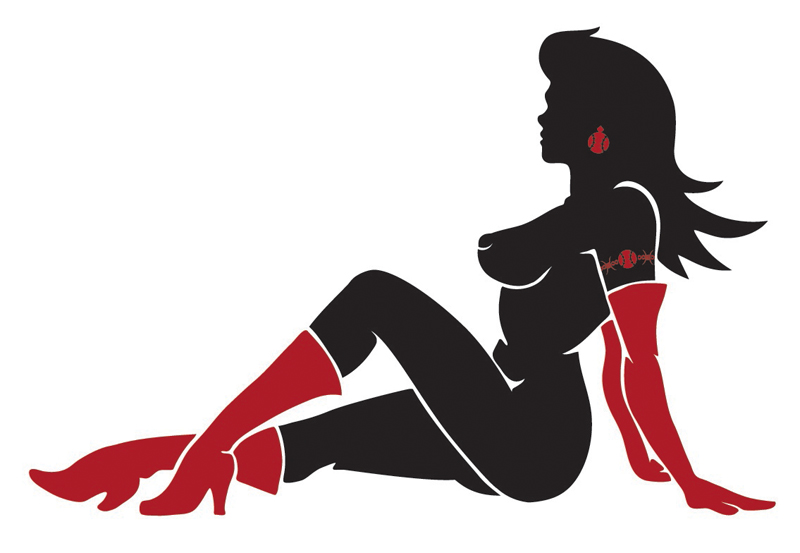
With John’s assistance, these guys are building hot rod twin cams with some very special confidential products. I’m hoping to bring you the story and access to some of these secret products in the near future. I mounted his intake with stock clamps.

After installing the rear wheel, we discovered the oil tank could not be installed from the front with the engine and trans in place, and we had to remove the rear wheel. It wouldn’t install from the rear without removal of the wind guard and one frame-mounted rubbermount. We made it work without removing the engine and trans.


At this point, we jumped around the bike looking for any project affording completion, without trips to suppliers, missing fasteners, or parts orders. We took a hard look at Spyke’s new BDL starter jackshaft fix. I’ve used BDL systems for ten years without a problem, and no starting hassles. It took us a while to understand this system. Basically, it allows the starter gear to bounce, not jam into the ring gear. Once we understood how the Spyke fix operated and the lack of spring travel in the BDL system, we came face to face with the benefits. We moved on to fitting the fender.



This tough 9-inch fender fit perfectly with some slight modification grinding on the Spitfire fender rail tabs, but the bottom front of the fender smacked the oil bag and prevented perfect alignment. With some heat and our shop press, we pushed a buffing groove in the fender. Then we cut the massive notch for the chain and the fender was getting damn close. Ray took up the grinding duties after I cut the notch with the plasma cutter.


Then we turned back to the oil bag, which we had grown nervous about some characteristics. This was a one-off, first attempt by the Spitfire motorcycle crew. They did a helluva job, but we noticed that the return and vent oil bungs were down the face of the bag, restricting oil capacity. We stopped by Gard Hollinger’s LA Chop Rods facility and asked for a couple of 1/8-inch pipe threaded bungs. Gard doesn’t manufacture that size, but he does make ¼-inch pipe thread bungs, which seemed foreign to me, but we stepped up.

This was a tough, and scary operation. I didn’t want to risk drilling and dropping metal shavings in the tank. Jim Murillo recently sealed the tanks and coated the interior. The alternative was a 2.2-quart oil bag over a 4-quart oil bag. We swallowed hard and started the operation of drilling the holes in the top of the tank. I turned the bungs down slightly so I didn’t have to drill ¾-inch holes in the tank.

Ah, but for every obstacle, there’s an opportunity. We discovered a perfect exterior clear oil gauge, fucking beautiful. We started to drill the holes in the top of the tank for the return lines.

We also had a squirrelly obstacle with the top motormount. The frame came with a chunk of tubing protruding directly down from the backbone under the tank. In the end of the tubing, the Spitfire crew welded a hearty bung, and it was drilled and tapped to 7/16 fine threads. I went on the hunt for some 7/16 hiem joints and McMaster Carr had a couple in stock. That was my initial direction, but it had its drawbacks.


I kept looking for alternatives and discovered a tab that was part of the Biker’s Choice top motormount kit. The slot in one end was 7/16-inch, and it pushed the hiem joint anchor spot out far enough for the pivot point to reach the stock hole in the top motormount. I went to work welding it, but Dr. Willie didn’t like my fix. I want to give it a shot.


We also ran into a return line problem with the stock Softail engine configuration. The return oil line from the filter pointed directly at the transmission. We straightened it and ran the line, then thought about running an oil filter. We went on a search for an old Cadillac power steering oil cooler. This turned into an afternoon excursion, hitting junkyards in our ghetto area and all the auto parts stores. At the last Auto Zone, we scored this Cadillac power steering oil cooler and made a mad dash back to the shop.


We considered running one of those front motor-mount regulator brackets, but I didn’t like the way it interfered with the mount and the engine fasteners. Since the frame was built perfectly for this application, we cut and fitted a chunk of rectangular tubing stock between the frame rails to house the Spyke regulator.

We drilled it, installed fasteners from the back, and welded them into place, forming studs on the front. It was good to go once we tacked it into the frame. This project has a devilish twist, since we plan to build it, then test ride for a month or two before a paintwork teardown. I’m not using nylock fasteners this time around, just lock washers. Some items will be TIG welded, whereas some will be MIG spot welded for the tryout period.

When I grappled with the Biker’s choice CV carb mounting system, including breathers, I discovered the Branch/H.E.S. intake difference. I was forced to slice and weld the bracket in an alternate position. That puppy will need to be ground and reshaped before powder coating. We moved ahead and I discovered my Goodsen Fantasy in Iron air cleaner was built for a Mikuni, so I traded with my son for his Roger Goldammer, hand-pounded, stainless steel unit.



What a sharp, well-thought-out chunk of artistic workmanship. Everything about his air cleaner was well configured, from the backing plate to the position of the fasteners. It came with all the necessary fasteners and two foam sock-like filter elements.

I have never liked the single bolt rear axle adjuster. It allowed the axle to float and shift from its required setting, which can be downright dangerous. I ordered some special fasteners and set to drilling and tapping the stern of the swingarm bosses. They were massive, solid chunks of Spitfire steel. It took some time, but now the axle is locked into position.

.jpg)
Then we started to grapple with the kickstand. The obvious choice was a weld-on unit from Mr. Lucky, but he didn’t have any in stock.

I needed to install the 3-inch BDL belt system, to see where the kickstand would hit. Some kickstands can be a bear to reach, or take up much needed ground clearance. The more I looked at the Spitfire forward controls, the more I didn’t want to mess with that area. The only kickstands available that might fit this configuration were pricey jobs, and I suspected they wouldn’t fit. I started to dig around.


This new BDL belt drive fell into place after I drove the pins into the engine pulley. The clutch slipped right into place, and then I carefully selected washers and shims behind the engine pulley until both pulleys were aligned.


This new system has just two big, tough, 3/8-inch stud fasteners and stand-offs. One has a step in it, and it took very little time to determine which position it was machined for. The rear stud hung over the ring gear and needed additional clearance, but I goofed. I used red Loctite on the stud, and I should’ve stuck with blue. I’ll have to remove the aluminum stud anytime I remove the clutch.




Then inspiration surfaced with the notion to run a rear kickstand. In searching my parts bins, I came across a wild kickstand base. Unlike the old ones from the ’30s to the ’70s, this one worked the same, but was heavy and cast. With Ray’s assistance, we came up with the materials and the notion to bolt it to the swingarm cap, which is held with two 7/16 fine bolts. I went to work while Ray peeled out for Cook’s Shootout in Bonneville.


I tacked and tested it until I was convinced I hadn’t completely fucked up. Then I cut off the tabs, and ground and shaped the massive chunk of steel. I TIG welded this puppy together, mounted it, and made a cool stop threaded into the frame.

Next, I’ll start wiring with Wire Plus products and the bike should run within a week or two. Then it’s off to Saddlemen for a seat. Hang on, the Mudflap Girl will live.

But wait, I forgot that we installed the Spyke Push-Button solenoid starter. It eliminates weak connections, starter relays, and starter button wiring. It’s a breeze to install, but it’s important to make sure, once the button is released, it’s fully clear of contact.



Sources:
Spitfire
Biker’s Choice
JIMS Machine
MetalSport
BDL/GMA
Wire Plus
Branch O’Keefe

Bennett’s Performance
Custom Cycle Engineering
The Magnificent 5-Ball Factory Racer Featured
By Robin Technologies |
.jpg)
Editor’s Note: Our 5-Ball factory racer was feature in Heavy Duty Magazine in Australia recently. It’s the largest selling custom bike mag Down Under. The story and the photos were handled by the amazing Smilin’ Doc Robinson, the longtime tech editor. I’ve left the story alone for your viewing pleasure. Enjoy.–Bandit
Many interesting and colourful characters populate the biker world and Keith “Bandit” Ball walks tall among them. And not only because he tops out at six-foot five inches. Lifetime biker, author, longtime Easyriders’ editor, custom bike builder, salt racer, founder of the premier web site Bikernet.com, Bandit is all this and more.
Get him settled in the comfortable lounge seat in his Los Angeles abode, pour him a stiff whisky, and sit back as he shares tales of the road, some that would make your hair curl, others that are genuinely side-splitting and always among them, lessons to be learned about life.
I figured that the best way to introduce this build to HEAVY DUTY readers is to give it to you in Bandit’s own words: “For decades guys have built vintage- looking scooters with late model drive-trains. Hell, I built another one at Strokers Dallas in the ’90s. Before I dreamed of it, Arlen Ness built a ’20s vintage scooter and sidecar around a Sportster engine.
Randy Simpson built vintage kit bikes. Don Hotop built some of the finest vintage-styled customs and recently I saw a ’20s styled bike at the SEMA show in Las Vegas built by the Shadley Brothers for House of Kolors. Beautiful piece. So I ain’t the first by a long shot. But there is something in the air recently about respecting the old iron and bringing it back to life. Some of it has to do with restrictions, and building older bikes is unrestricted. Some of it has to do with nostalgia and some is just a wild departure from the last project. I’m excited every year about this learning process.”
I asked Keith to sum up the vision that drove this build: “Well I built it in the teens vintage style, but with my height and long limbs I had to scale it up a bit. It’s built for long miles, with floorboards, a sprung seat, rubber grips, tall gearing and a spare gas tank. Every custom motorcycle build is an adventure. It takes me from one crazed time in my wild life to another. Fortunately, I’m not spilling my guts about another woman I lost during a knuckle-busting build. But this build did represent turning points. I’m rapidly closing in on my mid-sixties and about ready to sign up for Social Security. It also represented our stinky economy.”
Bandit is such an industry icon and it is not surprising that many of the leading lights of the motorcycle aftermarket were involved in this build, blokes like Ron Paugh of Paughco, leading manufacturer of custom parts and accessories for the past forty-three years, Rick Krost of US Choppers, Chica, who needs no introduction, Gard Hollinger of LA Choprods and HEAVY DUTY photographer Glenn Priddle who made the sweet seat.
Here’s Bandit again: “The key to the success of this project is the drive train. I sought a Crazy Horse V-Plus, 100-inch engine for several reasons. It has a classic design, renewed performance, cool looks and a left-side carb. I coupled it to a JIMS 5-speed transmission with a Baker kicker unit and Baker N1 shifting drum, so I can run the tank shifter and find neutral without a problem. The rocker clutch system I put together from old H-D parts while I fabricated the tank shifter.”
When he hasn’t got a fast motorcycle between his legs, or a whiskey in one hand and a beautiful redhead in the other, Bandit is happiest welding, soldering, wrenching, milling and turning metal in his secret and damn well-equipped lair beneath Bikernet HQ. His other love is writing, usually upstairs in his 1923 shop, behind his glass-topped Panhead-motor desk, rattling his computer keyboard, churning out another fiction book, a book for motorbooks, magazine articles (sometimes for HEAVY DUTY), or news, or one of dozens of tech articles for Bikernet.com.
And for those of you who are truly interested in the real guts of bike building, let me recommend reading the whole story of this build on the Bikernet.com web site. It runs over some eleven parts and is well illustrated with photographs showing each and every step of this build.
If you only read one part of the full story, make it Part 6 where you’ll see the immense amount of work that went into the rear fender fully detailed as master metal shaper Chica gets to work. But once again, I strongly recommend you read the whole thing as a salutary lesson on just what goes into a ground up build. Without the space limitations of a magazine Bandit is able to show and tell stuff that you won’t find elsewhere. To find it, go to Bikernet.com and click the Free Departments button and select Techs and Bike Builds and scroll backward through the various articles until you find Part One and take it from there.
I really dig this bike in every aspect; the concept of honouring old iron in this way, the marriage of old school looks with a nod here and there to practicality and safety, given that brakes back in the first two decades of the twentieth century were mighty primitive to say the least. I love that shifter in all its brassy mechanical glory, the vintage touches like the chain oilers and the leather strap holding down the battery and the cool fuel tank mounted up top to extend the bike’s range.

Having examined it closely, both during construction and in its completed state, I can attest that the fit and finish all over is excellent and detail touches like the pin striping are icing on the cake. Keith thanks Sin Wu for her part in this build and reckons this woman is a keeper, and I can understand that. This bike is a beauty and will look just as cool in fifty years from now. Way to go Bandit, I’ve seen several of your other builds but with this one you’ve climbed a pinnacle. HEAVY DUTY is proud to feature it in our pages.

BIKERNET EXTREME GUTS&BOLTS TECH CHART
ENGINE
Type: Crazy Horse Power Plus 100
Capacity: 100ci
Cases: Stock
Crank Stock
Bore: 3.874″
Stroke: 4.25c
Heads: Stock
Ignition: Thunderheart
Carburetion: S&S Super E
Manifold: Stock
Air cleaner: powder coated by Worco
Exhaust: Bandit built
Muffler: Stainless Scorpion from John Reed
Estimated power: 80hp
TRANSMISSION
Year: 2006
Type: JIMS
Number of gears: 5
Gearchange: Bandit built
Baker N1 Shift Drum
Clutch: BDL
Primary drive: BDL Classic powder coated by Worco
Rear Drive: Exile chain
SUSPENSION
Front: Paughco narrow tapered leg springer
Triple Trees: steel from Paughco
Mods: 2″ under length
Rear: Rigid U.S. Chopper design
WHEELS
Front: Black Bike dimpled 23″
Tyre: Avon
Brake calipers: GMA by BDL
Brake rotor: H-D
Brake lines: John Reed
Rear: Black Bike dimpled 23″
Tyre: Avon
Brake caliper: Exile
Brake rotor: Exile Sprotor
FRAME
Type: US Choppers vintage rigid
Make: Factory Racer by Paugho
Year: 2009
Rake: 30 degrees
Seat: Glenn Priddle
CONTROLS
Handlebars: Narrowed Flanders
Grips/levers: H-D, BDL/GMA
Risers: DPPB bronze dogbones
Master cylinder: GMA front
Mirror: Lowbrow
Headlight: pinstriped by George the Wild Brush
Footpegs/forward controls: Paughco vintage footboards
Rear brake master cylinder: H-D
Speedo/tacho/oil pressure: Biker’s Choice Vintage Sportster
Taillight: powder coated by Worco
Other modifications: rocker clutch system made with old H-D parts, Phil’s Speed Shop wiring harness and ignition system, alternator charging system by Spyke
GUARDS/TINWORK
Front guard: missing
Rear guard: Chica
Fuel tank: Paughco
Trim: gone
Oil tank: Paughco
Other modifications: Vintage H-D tool box and brake linkage by Paughco, Reserve gas tank by Mike Pullin
COMMENTS: This bike was built in the teens vintage style, but built for long miles with footboards, sprung seat, rubber grips, tall gearing, and spare gas tank. The plan was to ride to Sturgis, but I never got out of Dodge. Now the plan is to ride it to Arizona for the too broke for Sturgis run to Salome, a little sun burnt town in the middle of nowhere. But it has a very cool or western saloon on the edge of town.
Partners in Crime:

Road King 11/08/05
By Robin Technologies |

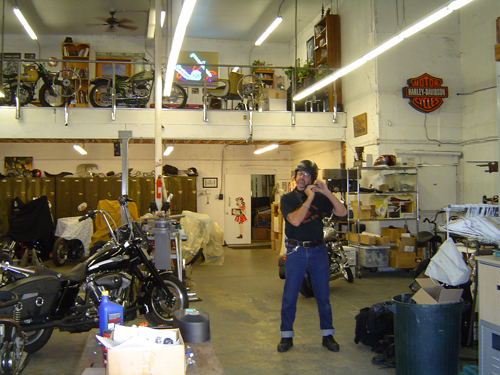
Around mid June Kerry and myself were organizing our trip to Sturgis, when Bandit contacted me an asked how would I liketo ride the Road King to Sturgis. Immediate thoughts were Wholly Shit, I’ve read all about the King on Bikernet and watchedthe different stages Bandit has put it thru, so I was very familiar with it, and for Bandit to be asking me was really a big deal, meaning, I felt honored enough when Bandit invited Kerry and myself to join them on the ride, let alone ride his bike. So youprobably guessed the answer was a big >>>>>> Yes Sir !! thank you very much.
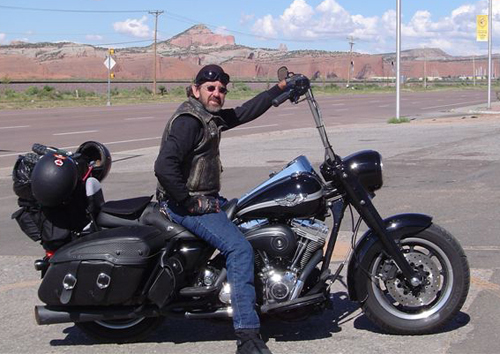
For the readers who aren’t familiar with the Road King, I’ll enlighten you. It started life as a stock 2003, 100th Anniversary model.Bandit said he designed the bike be a big bad assed, blacked out touring bike with heaps of attitude. Bandit and his crew wanted to use as many H-D parts as they could to prove you could build a mean assed bike out of Harley Davidson’s catalogue. They started by blacking out the dash, a set of one inch lowered air shocks and a detachable back rest along with some neat touring components. With the help from a dealer for some more involved tech mods to gain horsepower and some low-down torque, they came up with a formula by adding performance cams, Screaming Eagle Heads, air cleaner kit and two into one pipes powder coated black, giving them 68 horses compared to 60 and torque was 76 pounds with a 6 pound increase. Next they installed a factory oil cooler which Bandit tested on a run to Barstow saying how it kept the oil at a very reasonable temperature which is critical for long term, Twin Cam reliability.
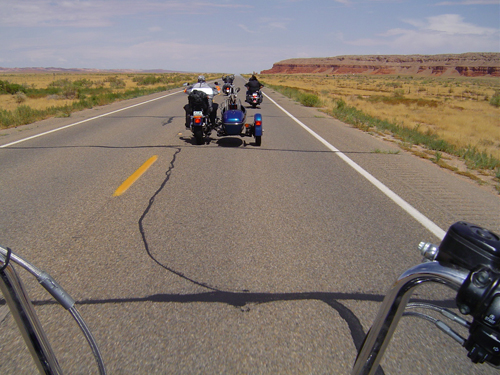
Fast forward to Sturgis, August 2005 and Kerry, my wonderful bride, and myself arriving at the Bikernet Headquarters being greeted by Bandit and the lovely Nyla. We were enjoying a beer while having a grand tour of their unbelievable home when Bandit said, “Get ya helmet Goddamit, we’re going for a ride.”
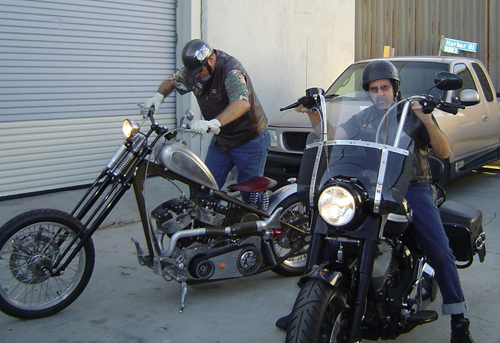
It’s hard to explain the excitement that was welling up inside of me, especially when I first laid eyes on Bandit’s bare boned, mean as shit Shovel, I swear it had a look like, let’s go, I’m ready. And right beside it sat the Road King.
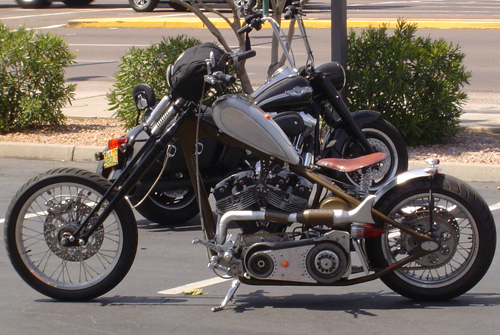
It definitely looked like itwas ready to do some very serious miles, man. It looked beautiful, all blacked out like a road warrior ready for action, 16-inch apes reaching for the sky, a very comfortable looking seat and a detachable back rest for Kerry. I gotta tell you these two bikes were like chalk and cheese, the Road King had all the creature comforts and Bandit’s Sturgis Shovel had absolutely nothing, excepta little back fender and a sprung seat, Shit !!! and he’s riding it to Sturgis, tough sonofabitch, I thought to myself.
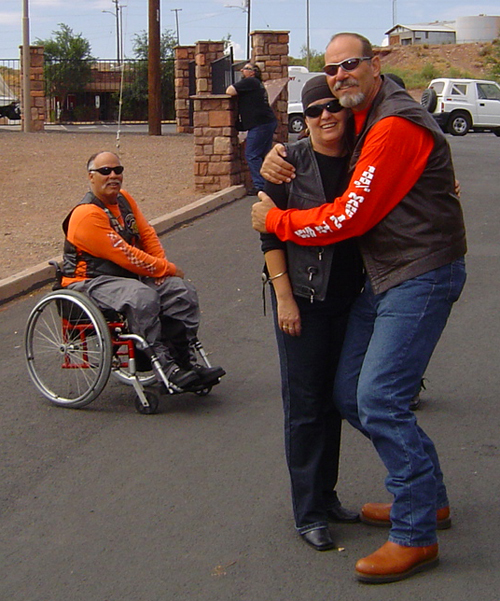
Just as the sun was setting over Long Beach we fired those puppies up and peeled out of the Bikernet Headquarters like two crazed maniacs going for their first ride after a long cold winter, ( sound familiar Bandit ). Seriously thou, we cruised around Long Beach taking in the sights and both of us getting used to our rides. We both had grins from ear to ear, especially when we twisted the wick on these babies, I was blown away, the King with it’s sheer size and weight, had some serious acceleration, man. I was impressed plus having a lot of fun and Bandit’s shovel went like a rocket, with it’s power-to-weight making it an awesome ride.
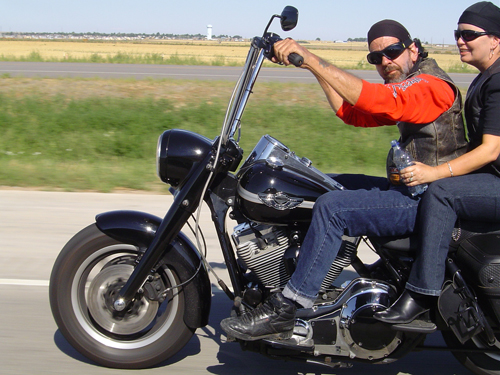
This was going to be my 4th trip to Sturgis (beginning in Australia) and I knew 100 percent this trip was going to be very special, I was feeling right at home on the Road King, everything was perfect except for the bloody windscreen, I think it was set up for Bandits 6′ 4” frame and I could not get used to it, but Harley had it covered. Two seconds and it was off, no problem.
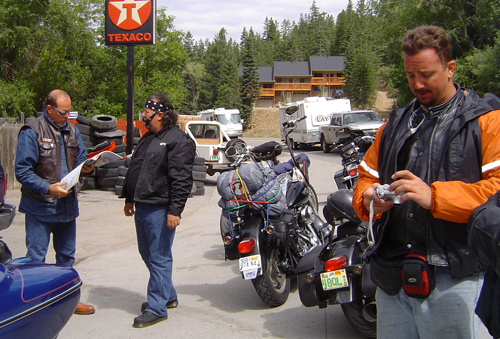
I would love to tell you about our trip to Sturgis, but it’s been covered by Bandit and Johnny Humble, the young gun from Texas, both really great stories and you can still check them out by going to The Events Coverage in Bikernets Department Site.
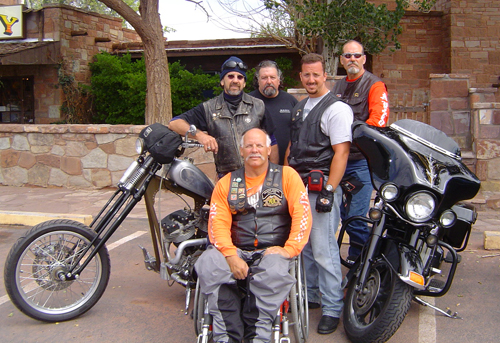
It’s hard to put into words, the true feeling of this road trip with such great company, I will say that we were very privileged to get to ride with them, even thou we live on the other side of the world, I know that Kerry and myself have forged life-time friendships and hopefully will get to do it again some day.
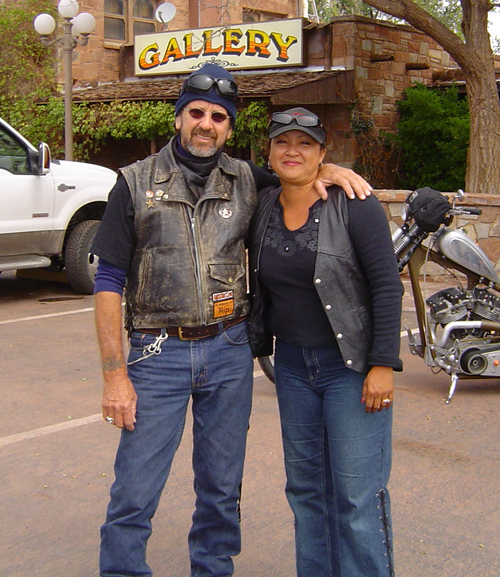
I have been privileged to ride a lot of bikes in my time and I must say the Road King was bloody brillante, we covered 4000 miles all up, came across all types of weather (as we all do) including high altitudes where the King never missed a beat with it’s superb fuel injection and very smooth motor. Seating was great, and I just loved the apes. Not only do they look really cool with an attitude, they were really comfortable.
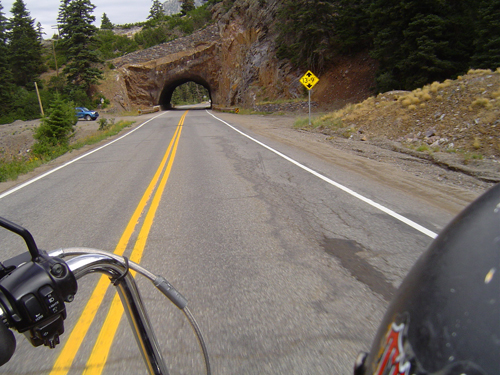
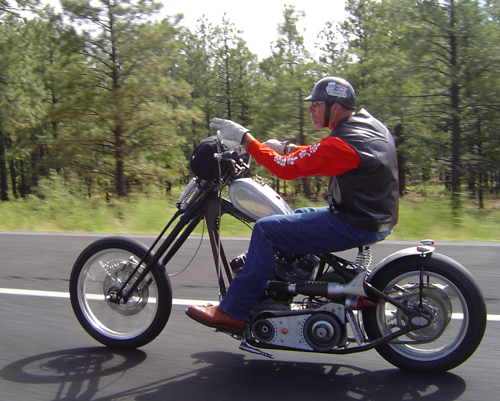
I will post some photos of our trip that you haven’t seen and would like to do a follow up of our trip from where Kerry and myself parted company from the rest of the crew, returning to L.A. via Denver, Santa Fe, Sedona and Vegas.

I would like finish up by thanking Bandit and Nyla for their friendship, hospitality and giving us such a great time, not forgetting the use of their Road King.
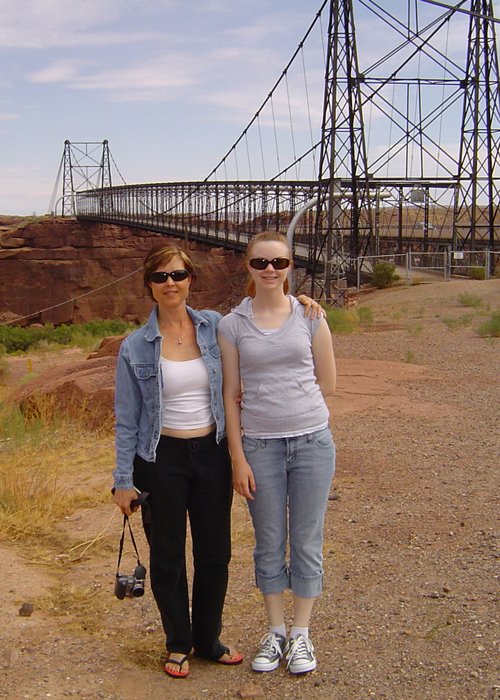
Okay guys thats a wrap, hope you like it.
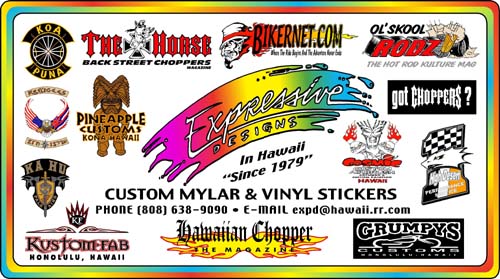
Mudflap Girl FXRs, Part 6 Wiring with Wire Plus
By Robin Technologies |

Wiring is always a treat, unless you use one of those systems in a box like Phil’s speed shop systems. I ran one on my factory racer, and it was a breeze. I’ll try to find a photo. It was designed to mount to the frame seat post. Inside it contained the circuit breaker, the starter relay, the ignition switch, the starter button, high low beam, and horn button. Then a ream of wire rumbled out of a hole. I guided them to the appropriate spots and hook them up. Nothing to it.

In this case, we worked with Wire Plus since they are the masters of wiring kits, Speedos and assorted equipment. They sent me a complete wiring harness with a starter relay, flasher system for turn signals, a 30-amp circuit breaker with mounting strap and rivets. They also included an installation and operator manual for model Wp192, Mid Frame Mount System, with Chopper style harness, with or without turns.

Their manual affords the reader a lighting circuit flow chart, an ignition flow chart, and an accessory flow chart. It demonstrates several ignition switch wiring circuits and handlebar circuits. It even comes with a Wp143 lighting control system for auto-canceling style harness. Actually, I checked the Wire Plus web site and they do make a seat post ignition switch wiring system unit, in a coffin shape, classic, and old school. They also make a cylindrical shaped engine mounted ignition switch housing, and ignition and toggle switches. They have systems that include compression releases–Amazing.

Wire Plus also makes individual wiring products, like their lighting control modules, power modules, plus custom power ports, for plugging in accessories. There’s a reason for going on and on about Wire Plus. Wiring can be a nightmare, and I’m a lazy. I want to be as minimal as possible, for ease and reliability, but I’m fulla shit. Just about the time I think I need to cut turn signals out of my system, someone is wiring in heated grips, or a heated seat, a some sound system, or neon lights under the engine. I avoid anything extra, like the plague. Hell, wire plus make engine mounted electrical port systems, so you can plug in your heated vest, helmet sound system, or whatever.

This is going to be a terrific test. My son’s bike will contain more bells and whistles, and Grip Ace controls in the bars. Tim from Grip Ace from Rivera is coming over to show us how easy it is. On Frank’s bike, we will install turn signals, so anything is possible. We will also wire a metric bike, the XS Yamaha bobber. So, over the next couple of months you will witness three variations, with Wire Plus products.



I start wiring by finding all the components and placing them somewhat in position. Then I search for a place to hide the circuit breaker and a circuit board, or bank of connections. First, we made a trip to the local Marine store and ordered an ignition switch. This included a starter switch, but we were using the Spyke push-button starter mounted to the solenoid. It eliminated the starter relay and any starter switches.

Once I determined a handy location behind one of the Mudfap Girl FXR panels, I drew up a wiring schematic, while referring to the Wire Plus handy manual for guidance. I came up with this nuts notion of hiding the ignition switch under the seat nose, which would position it perfectly for some of the wiring, and run some of it through the backbone of the frame. I grappled with a mounting notion, but Danny came up with the final notion, which took a lot of work, but was highly secure.


Wire plus makes several digital speedos, and several mounting systems for different applications. It was a breeze to mount and wire once I found the mysterious neutral switch connectors, which I ordered from the factory. The WP speedo mounted like a dream on the bars, once I plugged the wiring harness into the rear of the unit, ran the wires under the tank, back to the nerve center for power, then to the speedo sensor, and the neutral switch. Nothing to that one, although I wouldn’t mind running the wire loom through the frame in the future.






Since I was thinking about the rear brake pressure switch, I started to work out my GMA brake systems, and we made some measurements. I ran over to Baker Performance products and in five minutes we had new brake lines cut to size. This was probably the easiest bleeding process I have ever encountered. They were bled and working in no-time. Unfortunately, GMA doesn’t make a clutch lever to match.





On rubber-mounted bikes, I run two grounds. I welded one to the frame and I use one of the Spyke starter mounting bolts as an auxiliary ground. I don’t want to take any chances with the charging system, or the ignition system missing a grounding connection.


I needed to mount an On-On switch in the headlight bucket. It took some hunting for the correct sized switch, then a headlight seal beam from Biker’s Choice, and a lot of digging for a three blade connector. My headlight came from a spot on a police car in the ’30s.





Almost all of my electrical components came from Spyke or Compu-Fire. The Compu-fire ignition system is a breeze. This time I’m running a Compu-Fire single fire ignition system, with their single, dual wound coil, which mounts between the heads, in the standard stock position. It’s all too tight and convenient. Two wires to the coil and one to power and the system is good to go. It’s about that easy to time.

My son showed up with the missing parts for his Bub Bare exhaust system, and we started mounting it. I wish the exhaust guys would make kits with the flanges and retainer spring rings. Some systems come complete, but it’s a drag to run to the dealership, when you’re ready to rock. I understand why they don’t supply them with many system. If the system is replacing a stock system, we just switch out the parts. And these four pieces would jack up the price, but give the customer the option, and the manufacturer could make an extra buck and save the builder time and hassle.


This system slices damn close to $350 and you paint it with whatever heat paint, or heat wrap you like. It’s very similar to my D&D system.







Sources:
Spitfire
Biker’s Choice
JIMS Machine
MetalSport
BDL/GMA
Wire Plus
Branch O’Keefe
Bennett’s Performance
Custom Cycle Engineering
Saddlemen
Bub

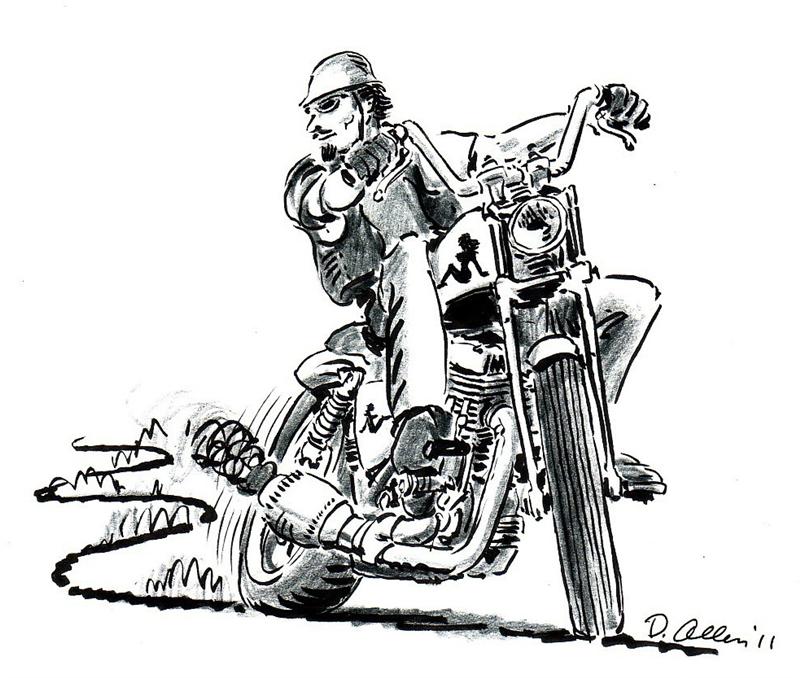
Mudflap Girl Part 4, the Spitfire Frames to Rollers
By Robin Technologies |
Suddenly we’re smoking on the Mudflap Girl FXRs, but the week after I received the frames, I had to jump a plane to New Orleans and ride a Victory to the Smoke Out. I was itching to work on these bikes.

I survived the Smoke Out, and since I just spent 1000 miles in a Victory saddle, I was motivated to get back in the wind. We looked down the barrel of the ticking calendar as I returned from the East Coast on Sunday and Monday the 27th of June I stepped back into the Bikernet shop and faced two Mudflap Girl FXRs on lifts ready to rock. I dove in making lists and started to assemble my frame and the Spitfire girder front end.

Building a bike is like falling in love. We all have our dream of the perfect woman, and each time I build a bike, that notion is the driving force. I’m building the perfect romance, with all the best intentions. I want this one to last forever, take me anywhere I want to go, and be my Mudflap girl baby in spirit, appearance, and function.

I would imagine the same mental scenario applies to a home building architect. In fact, we have focused some of our efforts on creating a vintage motorcycle coffee shop in the front of our building, Bandit’s Barista. Talk about a daunting process involving several city agencies. Let’s leave that one alone. Sin Wu came to a meeting this morning and immediately quizzyness engulfed her and she was forced to leave. “It’s too daunting,” she said.

We are so fortunate to be able to rely on our friends and compadres in this industry and build whatever motorcycle we want, then go for a ride without severe governmental restrictions. Meanwhile, back in the shop, I was completely astonished at Paul Cavallo’s talents and shop capabilities. He designed and manufactured every element of this classic girder front-end. As I installed his internal fork stops and began to assemble the front end with the Foose-designed MetalSport 2D wheel, I was constantly blown away at every intricately machined piece.

Although Dr. Willy bitched about the top motormount on the frame, I didn’t have a problem with it. It just forced us to face another brief obstacle, which will ultimately create a very cool linkage issue with a 7/16 pivoting rod end on the top like most FXRs.


But I’m getting ahead of myself. I installed the fork stops, then the Biker’s Choice neck races, the Timken neck bearings, and the Metal sport front wheel on the Spitfire ¾-inch axle. Paul set up his frames to take stock Harley 2000-2007 front and rear brakes. We are going to use factory brakes on my son’s FXR, but I’m running with GMA brakes currently manufactured by BDL.


I had to come up with a mounting system using Paul’s stock H-D brackets. It was a trick but worked out, with brass rod and steel spacers. I messed with it for a couple of hours. Ultimately the GMA caliper was centered over the MetalSport rotor and in a terrific position for bleeding.


Then I started to install the girder rockers and bronze bushings. I was careful to grease every component, and again I was impressed by the precision fit with each bushing and axle. I installed the trees on the fork stem and rolled closer to installing the girder structure. Everything just slipped together.





Unfortunately, I was missing one element of the front end, the brackets holding the shocks in place, so I shifted to something fun, installing mudflap girls on the Spitfire side panels. They make these Zeus fitting fastened aluminum panels out of street signs. The mudflap girls came from 2Wheelers in Denver, but the Arlin Fatland and Donna team is currently headed for Sturgis to the rally, which reminded me that Sturgis is just around the corner. If I had another month, we’d be riding the Mudflap Girls to the Badlands.


Next, I needed to install the rear MetalSport wheel and driveline. FXRs are tricky in this regard. The entire driveline from the engine to the rear wheel needs to be installed at the same time. We started with the swingarm, using the Custom Cycle Engineering swingarm axle and retrofit kits. Here’s what CCE says about these conversion kits.

SWING ARM RETROFIT KITS
Custom Cycle Engineering has developed a swing arm conversion kit that replaces the stock Cleve Bloc style swing arm bushings with spherical bearings. The conversion covers all the FLT and FXR models from 1980 to 2001. The swing arm conversion kit coincides with Harley-Davidson’s change from the Cleve Bloc bushing to a spherical bearing in all the 2002 and up FLT models.

The conversion over to spherical bearings in the early models dramatically changes the handling and tracking of all the FLTs and FXRs. The sticksion at the swing arm pivot is greatly reduced with the new spherical bearings. This allows for the swing arm to react quicker to any harsh road conditions, keeping the wheel in contact with the road. The use of spherical bearings also helps negate any lateral and torsional movement in the swing arm by the shear dynamics of a spherical bearing.

The swing arm bearing conversion kit is one if the positive answers to the inherent ill handling problems of the popular dresser models.

It was easy to install the new spherical bearings using our shop press and the special tool CCE provides with their kits. We pressed them into place with the CCE guide tool and red Loctite. Then we installed the swingarm on the transmission and the whole tamale in the frame, since the oil tank was out for sealing and some flat black protection. Ray C. Wheeler gave me a hand. We slipped the JIMS transmission and swingarm through the back of the frame sideways, then turned it level and aligned it with the frame mounting system. My son scored some used bare aluminum cleave blocks, and I ordered new H-D rubbers from Biker’s Choice. Watch how the rubbers and cleave blocks are mounted. They are like a small four-piece puzzle with guide pins in particular locations.


With the JIMS 6-speed transmission in place, we jacked up the trans for engine installation. With a centered Biker’s Choice front motormount bracket in place and the rubber biscuit we were ready to rock. Willie helped guide us through the process. Willie is a master with FXRs. He’s worked on bikes, and rebuilt engines and transmissions forever. He knows all the tricks.

With the driveline in place, I started to monkey with the D&D pipe mounting, mounting brackets, and mounting the GMA rear brakes. The brakes became tricky, since Paul designed a tougher and wider swingarm, but it worked out perfectly. I’ll get to that puppy in a minute. I noticed that the trans didn’t come with the final seal and locking nut, plus we needed to reach out to JIMS for a proper offset sprocket for the 180 Avon tire. Since this is an 80-inch Evo, I wanted some gearing advice for the 6-speed overdrive transmission.



Here’s what James Simonelli wrote while packing for the Sturgis Rally and preparing for their install facility. Call them quick, if you want an upgrade while you’re in town.

MUDFLAP GIRL GEARING ADVICE FROM BAKER DRIVE TRAINS–
22-51 with normal 37-24 primary is 3.57, pretty lively! In 6th (.86)
you would have 3.07
23-51 37-24 gives 3.42 and 2.94 in 6th. I think that’s where I’d start.
To compare, most stock late models with 70/32 belt and 36/25 primary are
3.15 overall in 5th.
It’s nice to be slightly below 3.0 in 6th for 75 mph cruising. If it’s a
stoplight burner, go the other way.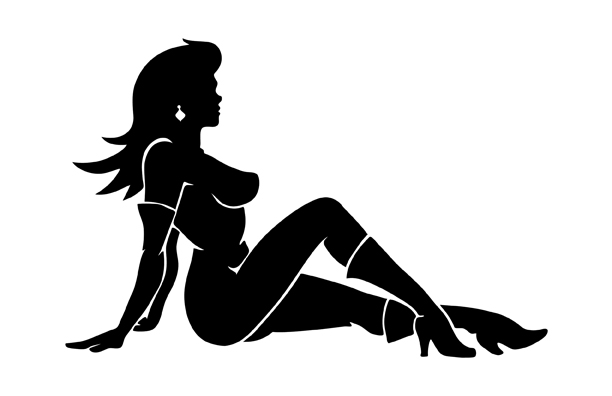
Baker will be set up in Sturgis on Lazelle performing installs. If you would like your 5-speed modified into a 6-speed, or a special Baker oil pan added to your dresser, set up an appointment soon, and tell ’em Bikernet sent ya.









We ordered a rear sprocket spacer and a dished 51-tooth sprocket from Biker’s Choice. It’s always somewhat a roll of the dice and I try to build a selection of spacers to allow me a variety of spacing options. With the JIMS ½-inch offset 23-tooth sprocket and the centered wheel, the transmission lined up perfectly with my brand new O-ring chain. It had never been removed from the crumbled box after a trip or two to Bonneville. I pulled it free from its container and the bastard was covered in rust.

Chad from JIMS sent me a photo of the mainshaft seal-installing tool. I also ordered the seal spacer, but had an installation question.

“Tech says bevel side faces into trans,” said Chad. “I have attached an image of the
needed tool, #786.” I dug through my special tool bins and found something from JIMS that would handle the trick.


In the meantime, our sheet metal returned from Jim Murrillo, who sealed the tanks with Caswell and gave the exterior a protective primer coat. It was a rush to slip the two gas tanks into place but we ran into a problem with my oil tank. I almost had to take the engine and the trans out of the bike to return it to its rubber mounts. Ah, but we succeeded.


Now all the major elements are in place, but the Sturgis Run is moments away. We plan to load my Sturgis Shovelhead onto our trailer, with the 120-inch Panhead, the Salt Shaker for Mr. Wheeler to ride. We will snap the trailer to the Bikernet hearse and cut a dusty trail in a couple of days. While I’m in the Badlands I’ll be thinking of Mudflap Girls and getting back to the builds. I’m sure I’ll return with more ideas, and next year will be the year of riding FXRs to the Badlands.


Hang on for the next installment as we mount up the Trock-modified CV carb on my ride, and the Mikuni 42 mm on my son’s bike. We have wiring harnesses from Wire Plus, and I have a rare intake manifold from H.E.S. and Branch, that was ported by John O’Keefe. We’ll be rolling close to final assembly as I install my BDL belt drive system and Frank’s mid controls. Goddamnit, I can’t wait.

Sources:
Spitfire
Biker’s Choice
JIMS Machine
MetalSport
BDL/GMA
Wire Plus
Branch O’Keefe
Bennett’s Performance
Custom Cycle Engineering
Saddleman Improves the Amazing Shrunken FXR
By Robin Technologies |

SADDLEMEN MODS TO THE SHRUNKEN FXR–In a world where over promising and under delivering has become all too common here is a gem I must share. The Bikernet built Shrunken FXR has become my daily rider and needed a couple small adjustments to be just perfect for me.
One detail was the too small seat or the bike was too fast (pick one). So I rode my bike over to meet the nice folks at Saddlemen and see what they could do to help me out with my seat. Upon arriving at the Saddlemen facility I spent time with guys from the front office to the guys in the shop ( all of whom took great interest in my motorcycle and the seat they were going to design and build). I noticed from the get-go these people were all riders. I shouldn’t be impressed by that, but there are so many folks in this industry who don’t even ride anymore.
We discussed what I needed (lumbar support) and a lip on the edge of the seat to keep me from being bucked off or sliding onto the rear fender. We also discussed the lines of the bike and that in the case of the Shrunken FXR , less was more. After the team and I spent a great deal of time figuring out what we wanted and didn’t want I was able to walk around the shop and see the whole seat making process from start to finish. man was I impressed!
So many talented folks all working together to put out an amazing array of products designed by and for riders! It was a real treat to see this and made me truly appreciate what they do much more. Great companies, in my opinion, are made of the people who work for them. So I left my bike for mock-up, and received a call back in a week.

When I showed up I saw the foam of the seat had been formed and pan had been constructed. We discussed coverings and stitching, again less is more. They got it and even pointed out to me the lines of the bike would be reflected in the seat.

Three days later I returned to pick up my bike and see my new seat! A seat is the finishing functioning touch to any motorcycle (much more than something you sit on) it must reflect the bike while being comfortable and a key suspension element.

I was so happy to see the seat. It looked amazing and really I could not have imagined it any better than they had built it. I put my helmet on, thanked them and jumped on the bike to ride away. First thing I noticed was the lumbar support made the bike so much more comfortable to ride and kept me in the perfect position to reach all my controls.
The biggest difference was when I hit a huge pot hole (tons of em’ in area) was my ass stayed firmly planted in the seat and the impact was minimal. The seat made my bike complete.
Can’t say enough about how impressed I was with the Saddlemen crew and facility, in short they made my custom bike have a perfectly functional and stylish seat. The perfect blend of function and form. I suggest anyone who needs a seat built or customized give them a call. They are a family team of bikers designing and building products for bikers. I like it!
–Buster
Road King 12/04/02
By Robin Technologies |

Yep, these techs will be backwards. I just rolled in fromArizona after the first 1,000-mile test ride after installinghighbars, performance parts, and modifying the windshield to fit thehighbars. So why publish the techs backwards starting with thewindshield? We’re lazy. This one will be short and the next two,since Frank Kaisler was involved, will be mammoth techs withthousands of photographs. Hang on for them, but if you’ve installedhighbars on a Softail or a King model and have long arms like myself, the windshield may be a problem to attach, but there’s acareful, simple cure.
First put the shield in place and decide if you can endure ahandlebar adjustment or not. If you pull the bars back in line withthe front end, the windshield will fit without a problem. You mightcheck it for 80 mph flexing which could cause rubbing against thebars, cables, brake hoses or wiring (if you didn’t run the wiresinternally). I took short wire ties and held small soft stripes ofrags around the cables that would have been damaged.

So I shoved the bars forward until the windshield would havefallen off the front-end. I’m not a big fan of windshields, but whenyou plan a ride through a 1,000 miles of rain, cold and wet highways, it’s a plus. I used the adjustable windshield from Harley-Davidson which allowed me to raise or lower it. I discovered that the lowered position is actually more comfortable in the rain. If I had raised it, I would have looked through the shield which was scattered with water and streaks. Visibility sucks and distraction wasoverwhelming, so I lowered it and my visibility was perfect while stillmaintaining the comfort and protection of the shield.

So what the hell did I do? I cut scallops in the plasticshield. First I marked off the area of the shield that had to beremoved with 1/4-inch masking tape and began to grind through theplastic with a bench grinder, the finer of the two stones. I tookcare to keep the edge of the plastic aimed down so the stone wouldn’t grab the sonuvabitch and crack it. I ground one corner then the next to search for a basic rounded feel. I avoided sharp edges or grooves that could crack. Since this was no perfect established science, I took my time slicing notches then slipping the windshield into place. I went back and forth to the grinder over and over. You might want to wear a breathing filter during this process and eye protection.

Once I was close to the finished area on one side, I took thewindshield to the vice and with leather pads on either side of themounting bracket clamped it down. Then with a high speed drill and a burr bit began to cut and shape some more. This, I found was difficult and took care not to allow the bit to grab and cut into theclear surface, but I was able to clean the edge some more. Ire-installed the shield again and determined that I was damn close.

Keep in mind that this was a last minute operation onThanksgiving day, between writing projects and packing for a run tothe desert. As the evening closed in it began to rain, a rarity inthis neck of the woods. I jogged in the house and flipped on theweather channel. The gods of the Roulette table had decided that Iwas not supposed to ride this weekend. The only rain east of theMississippi was dead over the 10 interstate from Los Angeles to theArizona State line. That made the windshield project even moreparamount. I dashed back to the garage.

Once I was close to the necessary fitment, style andprecision matching became a consideration. I ran a piece of maskingtape up the side of the stainless steel strut straight up the shieldas a measuring guide. Then I measured up from the horizontal strut to where the cut began. With these measurements I was able to compare them on the opposite side for an even scallop into the shield. I went back to the grinder and to the burr device for the final shaping. I continued back and forth a dozen times from the grinder then the high speed drill and back again. Once I had it nailed down, predominately with the grinder, I used an emery bit to smooth the edge of the Plexiglas.

That completed the cutting and shaping although the unitdidn’t lock entirely into place. I knew that once on the road thewind would prevent it from escaping. One small wire tie held thespring lock on the detachable windshield to the clutch cable foradded insurance. Just under 1,000 miles later I pulled back into SanPedro with a completely successful ride under my sore ass, provingthat careful mods to the Plexiglas windshield are completelypossible. Rah, rah.

Road King 12/20/02 Part II
By Robin Technologies |
I couldn’t think or speak. I had a week and a half to insure that this puppy ran. I could sense fangs growing under my upper lip. I began to snarl as my fingernail extended beyond my cold hard hands. My eyes reddened, and I wanted to ride. Without the throttle cables I could use the cruise control, if it still worked. I could jam it into gear and fly. Frank hit me with a torque wrench. “We’re burnin’ daylight,” he snapped, “Let’s measure the cables and install the left Knuckle style grip.”
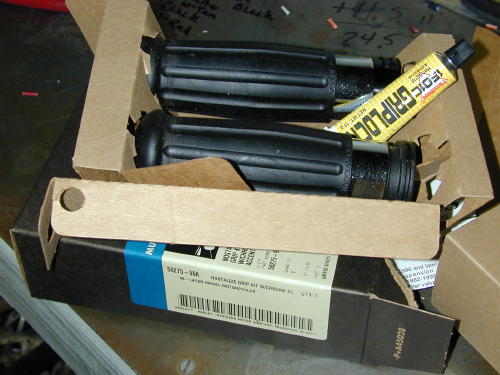
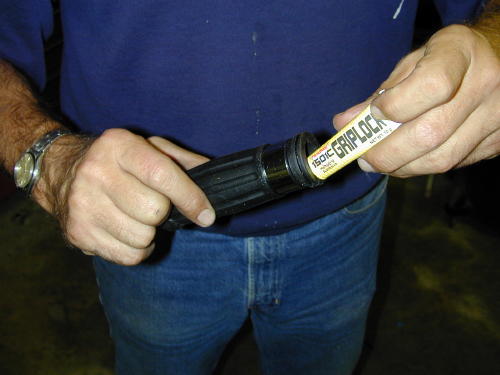
After wiping the grip end of the bar down with alcohol, the grip interior was coated with the rubber cement, that came with the grips. Then it was immediately slipped into place.
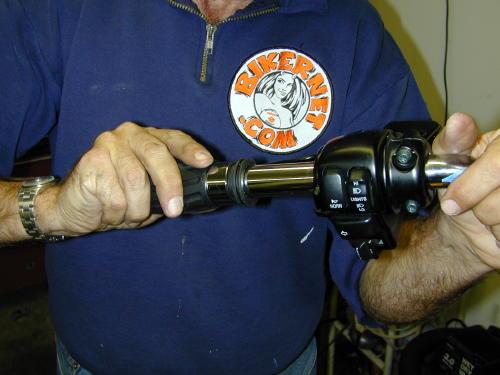
I snapped out of my Werewolf London fog. We measured the clutch cable then compared our findings with the throttle cables. As I suspected, lucky 13 inches to make up for the 12-inch taller bars that were an inch wider than the stock units. Frank made a B-line for the phone to call Barnett’s and ordered the cables. We were scheduled to roll up to the fleet center for a performance upgrade on Friday. It was Tuesday and the cables wouldn’t arrive until Thursday. It was going to be a close call. “Barnett has been around since Moby Dick was a minnow,” Frank said. I’ve been ordering custom cables from them since I was in my 20s and first influenced by Apehanger madness. “They are as reliable as the sun on the coast,” Frank continued, but I was still nervous.
We weren’t done yet. We torqued (15 foot pounds) the bars into place and began to cut and fit Goodridge brakes hoses, distributed by Barnetts and Custom Chrome. Another delicate operation.
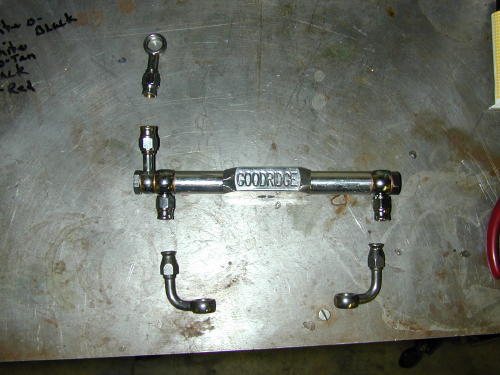
The King has dual disc brakes and the fittings had to be installed just right, tightened properly and finally torgued into place. From the bottom of the triple-trees we used the stock measurement to the calipers from the existing junction under the trees. The new lengths of Goodridge hose were cut with the largest, strongest side cutters I had. Before any fittings were installed we slipped a 2-inch piece of black 3/8-inch diameter shrink tubing over the hose. Next a chromed pinch fitting was slipped over the cable. Frank brought the tools and supplies including a tool to spread the braided hose after the rubber housing was stripped away to allow the new fitting to be installed.
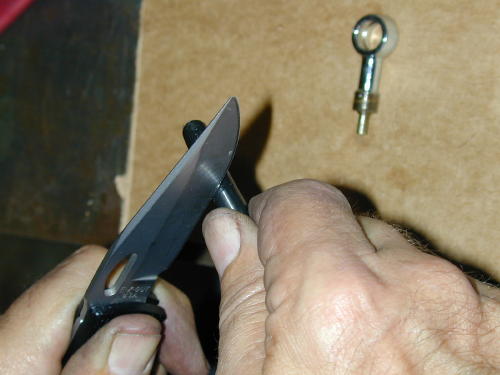
Stripping the rubber sleave back from the end about an inch.
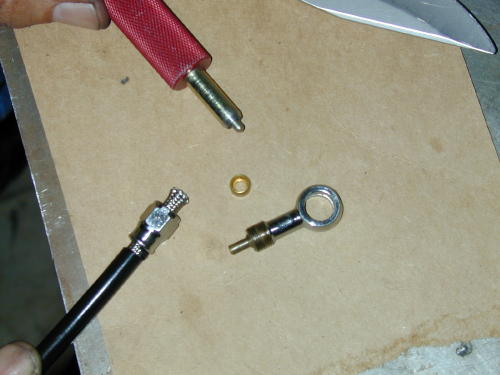
Here’s all the components involved in the process.
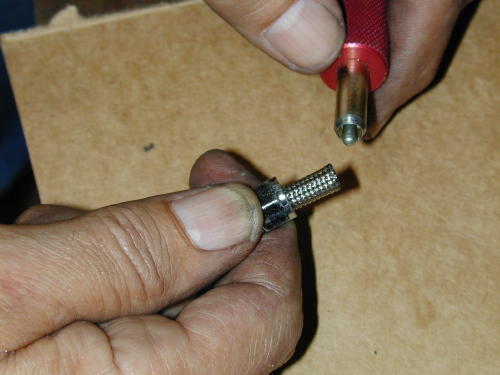
The tool used to spread the braided steel shield.
Then a small brass round furl (like a brass ball-bearing with a hole in it) is slipped over the plastic lining. It must be pushed to the point where the internal brass ridge meets with the end of the plastic liner. The other half of the fitting with the long tube is shoved into place. In each case we clamped the fitting between two sheets of leather then began to tighten the sleeve onto the fitting. In each case they were a bear to tighten down indicating that we had succeeded in a strong, secure grip.
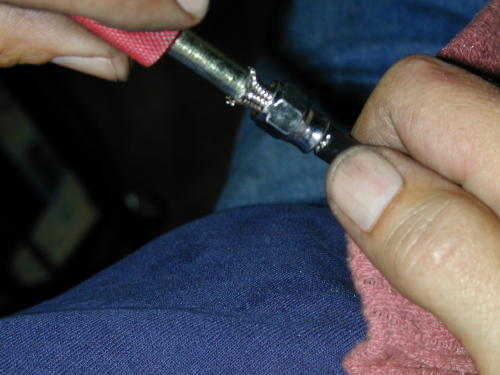
The spreading process involves shoving the tool into place and swiveling it to make sure the braided area is spread consistently.
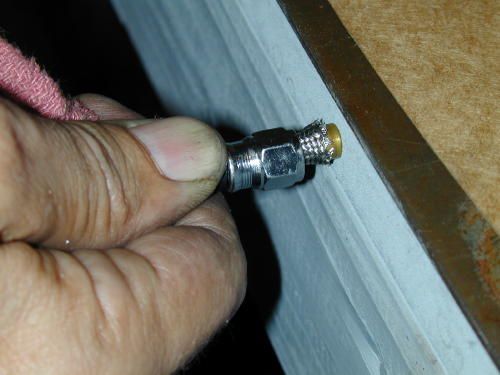
Installing the furl is simple, just slip it on carefully then push it into place. But, inspect the inside to make sure the plastic hose is against the interior ridge.
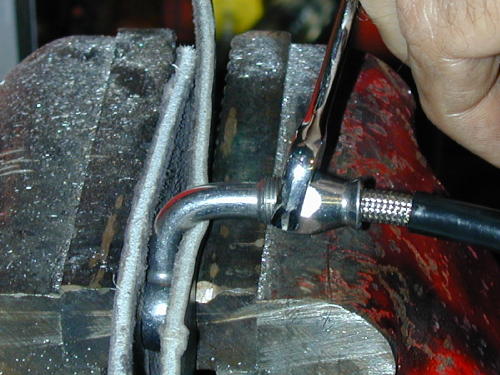
Now tighten the pinch fitting. Note the leather pads in the vice to prevent damage to the banjo fitting. These puppies are tough to tighten down, take your time.
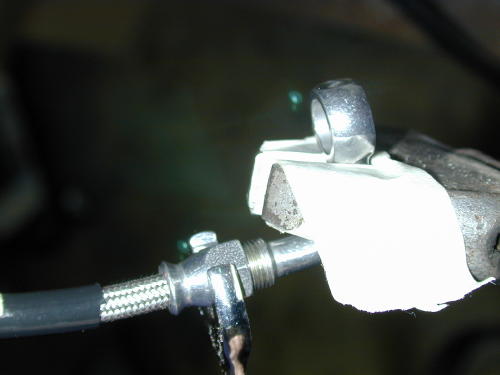
Here’s another way to hold the banjo fitting for final tightening. Be careful not to bend or damage the sealing surfaces.

Note the two bronze washer/gaskets on either side of the banjo fittings for proper sealing which is critical to your brakes.
After each line was carefully constructed, they were installed on the bike after some jockeying with the Goodridge billet junction under the tree which fit precisely.
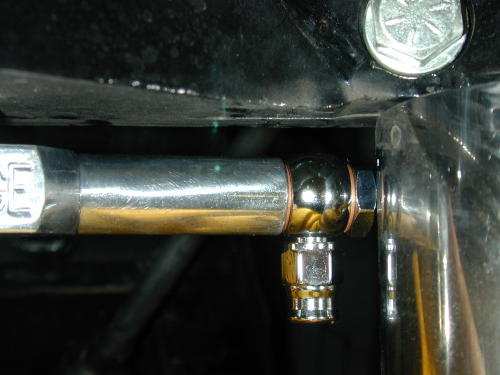
For some reason, this Goodridge junction mounted extremely snug between the fork tube guards. For awhile we thought we were in trouble.
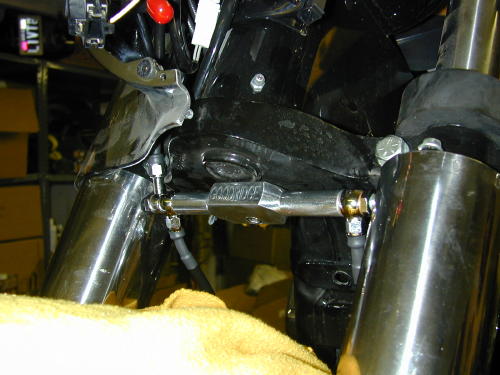
We followed the original routing of the stock brake line through the nacelle. With the lines in place we torqued them down (17-20 foot pounds). I took the easy way of bleeding the brakes. I pulled on the lever gently allowing the bubbles to pass through the master cylinder. It took a while, and I had to keep filling the reservoir as the the lines drained the supply.
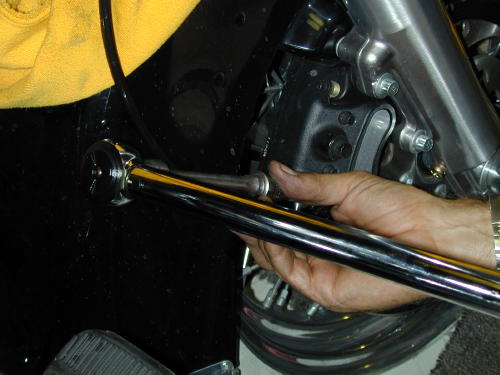
We used the stock 12-point fittings which torqued down easily to 17-20 foot pounds, which seemed like a lot.
We had completed all that was possible for Tuesday and I swung my leg over the saddle once more. As fire and smoke poured from my ears Frank crept out of the garage and into the night.
Thursday morning I paced the vast porch in front of the headquarters waiting for the UPS man. The truck sped past without a hint of slowing. I called Frank, he called Barnetts. I called the Fleet center after finding that the cables wouldn’t arrive until Monday morning, guaranteed. We had an American Rider magazine deadline, but more importantly I had a run-to-Arizona-deadline for the following Friday. I started pacing the garage and bowing to the new 16-inch apes. I knew, by the power of the Ape, we would succeed.
At 9:00 a.m. in my boxer shorts, Monday morning, I met the UPS man and signed for the Barnett package. I started to lube all the cables then decided that I should get dressed.
In order to install a new clutch cable the face of the transmission must be removed. I was surprised that this was the first item that I ran across on the King that was a pain in the ass to install. The entire exhaust system had to be loosened all the way back to the rear muffler isolator. before the clutch release housing could be removed.
With large clip ring pliers the throw-out mechanism was set free to release the clutch cable which virtually snapped into place. Then the cover was spun to allow the cable housing to unscrew. Next the new cable was fed along the same route as the stock job.
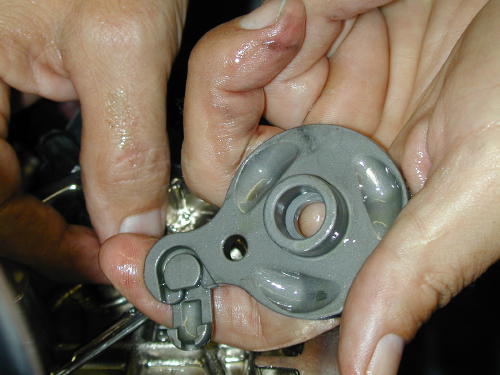
Once the clutch release cover is removed and the clip ring snapped out, you can see the outer ramp with the coupling ready for the cable.

If you look close the cable has been fed through the hole and is heading towards home.
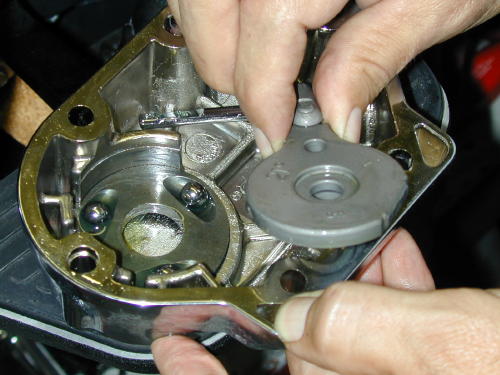
Now with the new cable attached the outer ramp heads back into position. Watch you don’t tilt the case. The ball bearings will escape.
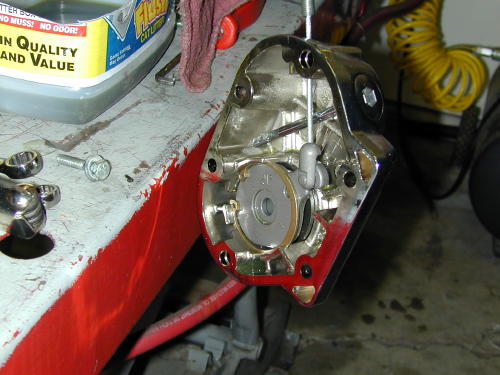
This shot shows the entire clutch release assembly complete. Remember as you reposition the clip ring to put the sharp edge up for the most secure bond.
We discovered that we had a lot of slack and rerouted the clutch cable outside the front motormount to eliminate some. Then the tranny cover gasket was wiped clean and the cover replaced (torqued to 10-12 foot pounds), then refilled with tranny fluid to the appropriate level with the bike upright and the dipstick threads just touching. We filled it to the top dipstick mark, about 3/4 of a quart capacity.
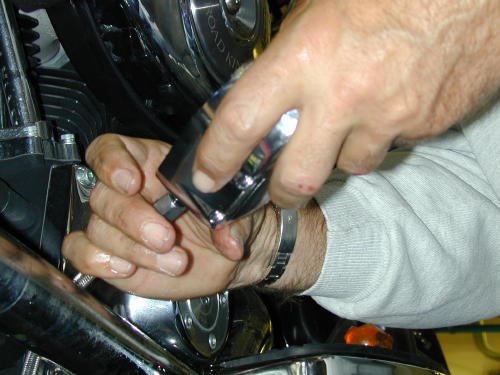
With this assembly you spin the cover onto the cable, not visa-versa.
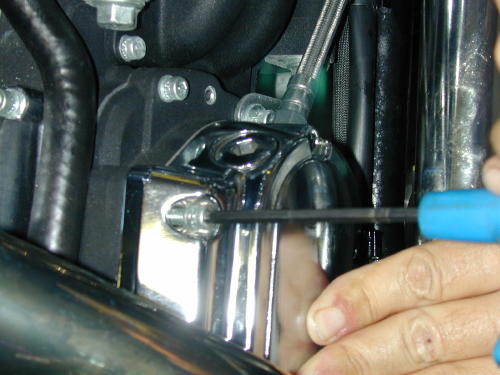
According to the book, the torque specs call for 10-12 foot pounds of torque to snug up the clutch release cover.
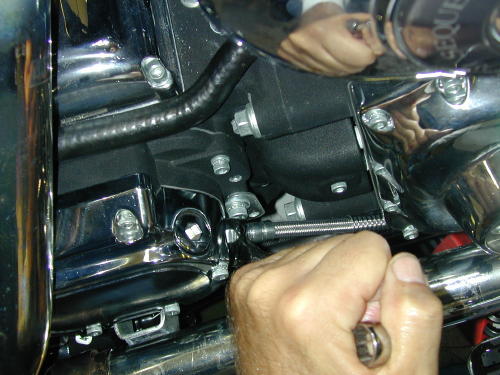
With a 9/16 box end wrench snug the cable housing down with a new o-ring attached.
We jacked-up the gas tank to afford us access to the fuel injection throttle cable routing. With the three tank mounting bolts removed the tank was lifted easily until a chunk of wood could be wedged under the front of the tank. Then I figured out which cable was what. With a small Crescent wrench, I loosened the throttle cable adjusters and took out all of the adjustment to allow lots of cable slack.
The unit with the small spring around the cable at the throttle body end was the push cable. I fed the braided cables through the runners as if they were stock cables. You will note, if you attempt this, that there is a Cruise Control connection in one of the stock cables at the neck. We unplugged it with trepidation. I wasn’t sure what havoc it would cause. I hadn’t tried the Cruise control. As it turned out, it’s a sensor to kill the control, if you back off the throttle abruptly.
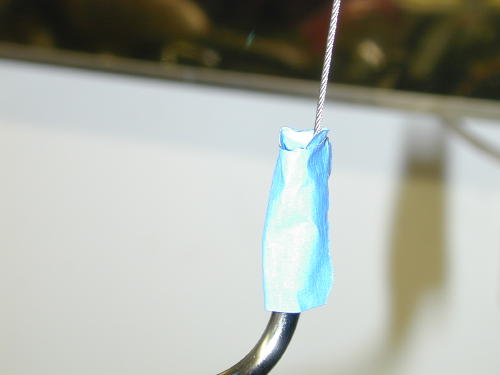
Lubing throttle cables starts with wrapping the cable housing with a little masking tape to create an oil container. Fill it with a light 3-in-1, silicone, or Marvel Mystery oil and let it seep into the housing. Fill it several times.
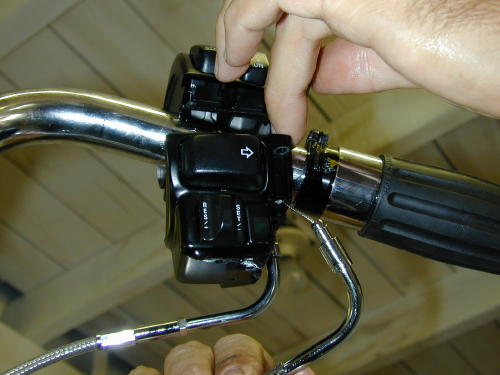
Feed the cables up through the throttle casing. With a little force they will snap into place.
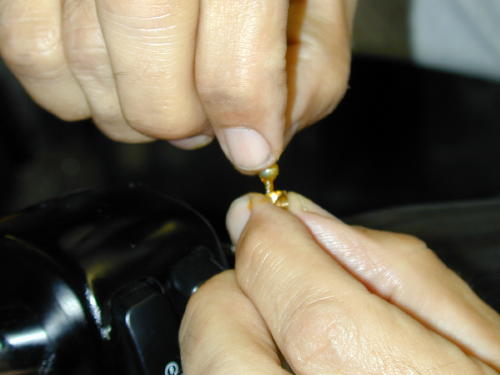
Make sure to grease the brass barrel before installing it to the cable end. The grease will help hold the barrel in place.
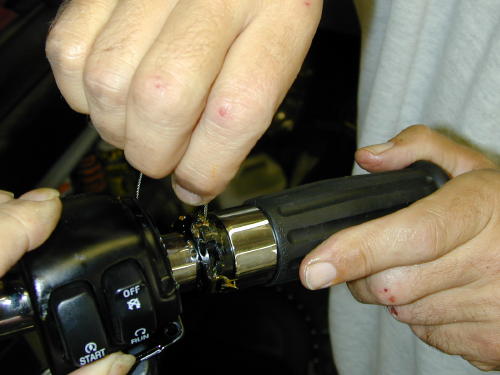
With the Barnett cable set at the most slack position, slip the barrel and cable onto the greased throttle guide grove.
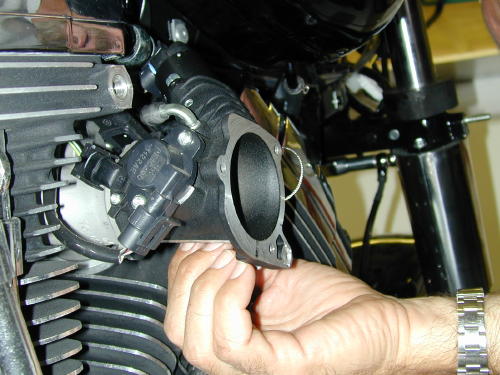
This is not a good shot of installing the cables into the guide slots in the intake module, but it’s easy. Just make sure you have the right cable in the right slot. It doesn’t hurt to grease them which we forgot.
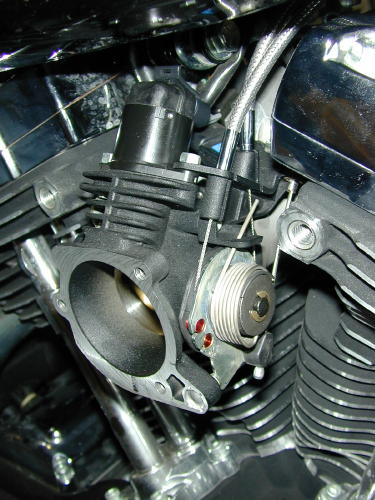
Here’s the cables in position. That odd short cable on the side is the cruise control job.
Make sure you oil the throttle cables before they are snapped into the throttle housing on the bars, because the spring clips that hold them into place are a bitch to remove. The cables were both put into place with brass rollers, “After you grease the throttle and cable runners with a Q-tip,” Frank reminded me. Be careful not to lose those tiny brass suckers. I was told later to try to adjust the cables evenly under the throttle and make sure you have slack in both lines so you don’t have continuos drag on the cable fittings.
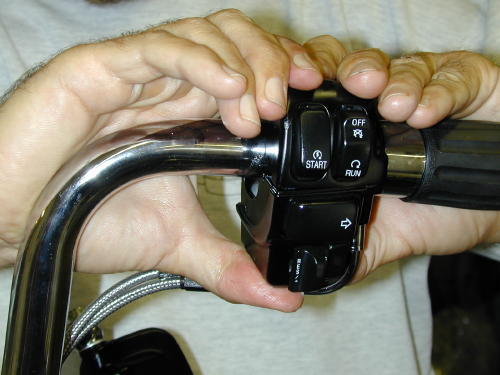
Here’s the throttle body in place waiting for the front brake mastercylinder.
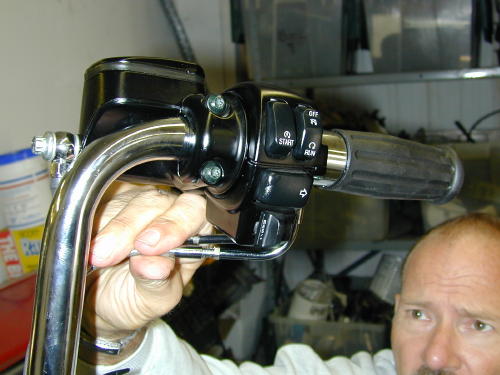
According to experts, you should adjust the cables so that the adjustment screws are approximately equal in length. My adjustment had to be straightened out at a later date.
Finally we replaced the air cleaner backing plate using Phillips screwdrivers to hold the gasket in proper position. Next the breather hoses had to be pushed onto the head fittings and lined up with the air cleaner element. Lastly the cover was installed. It was time to ride.
But not so fast Kimosabe. We had to install the riser cover, the nacelle trim and the headlight assembly. We were hauling ass.
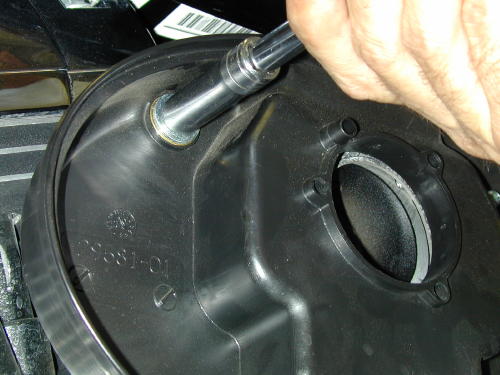
The actual breather fittings hold the air cleaner backing plate into place.
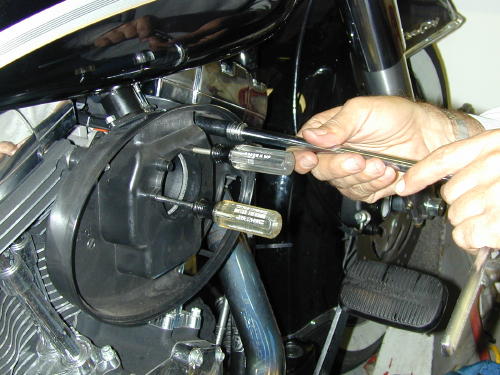
Use small Phillips screwdrivers to hold the air cleaner gasket aligned.
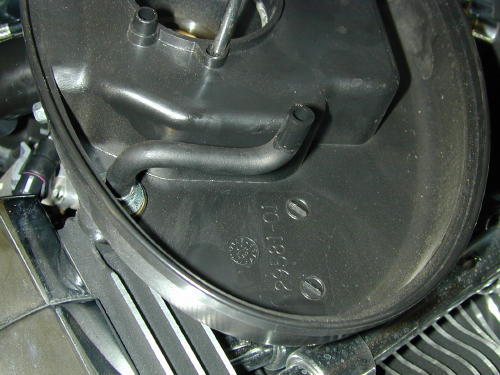
Push the hoses into place keeping in mind that they feed into the air cleaner element.
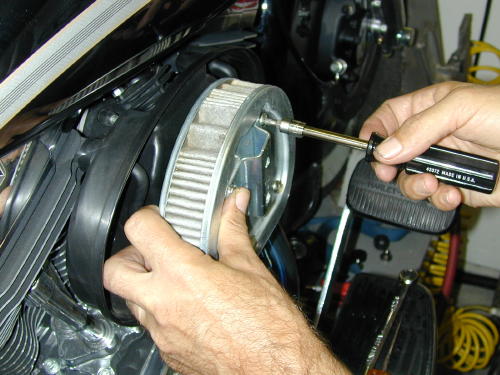
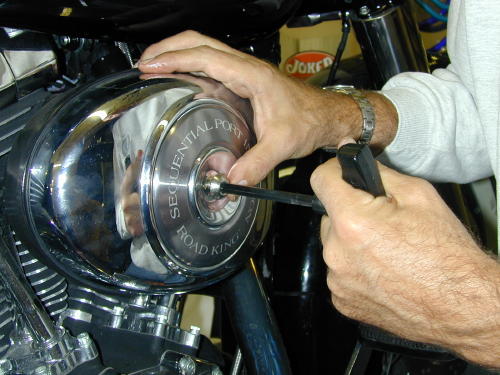
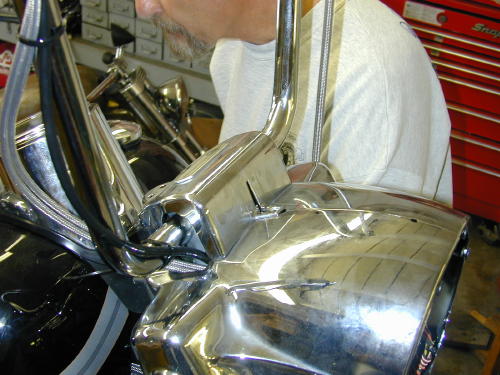
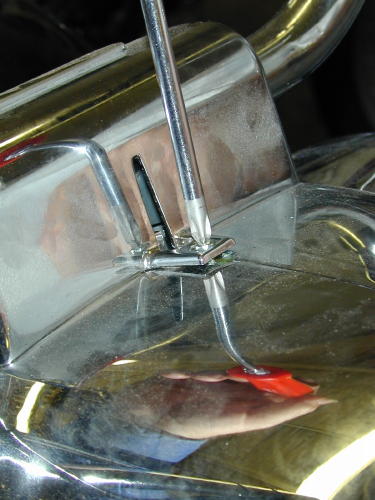
This little nut and screw are a bear to replace but must be handled before the nacelle strip can be installed.
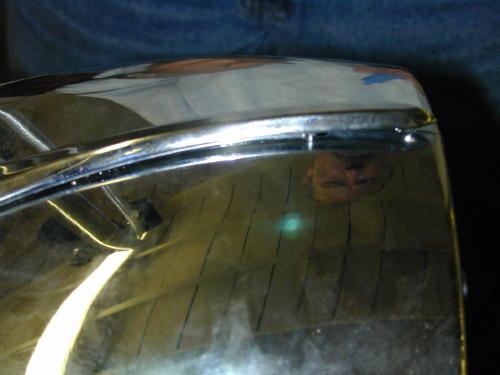
This slightly out-of-focus shot shows the little stud that slips through the nacelle. Make sure the strip is locked into the riser cover slot before you tighten the nut.
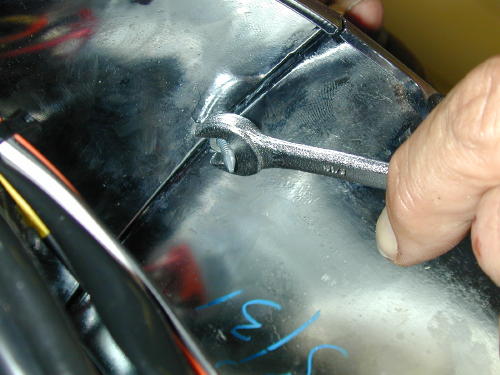
Tighten the nut lightly with blue Loctite to keep it from rattling loose.
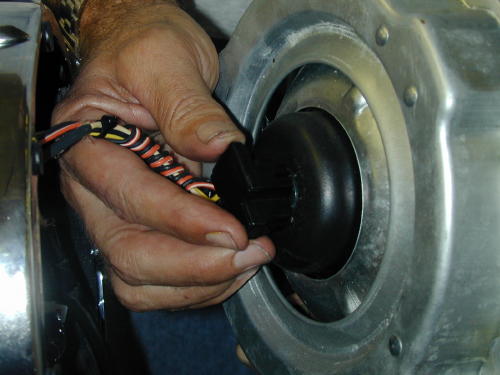
Don’t forget to plug the headlight in before you install it, like I did.
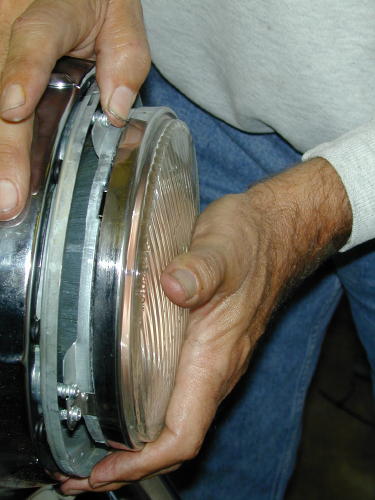
Install the headlight assembly with all eight black screws. Leave the bright adjustment ones alone, unless you lowered your bike. Then it needs adjustment.
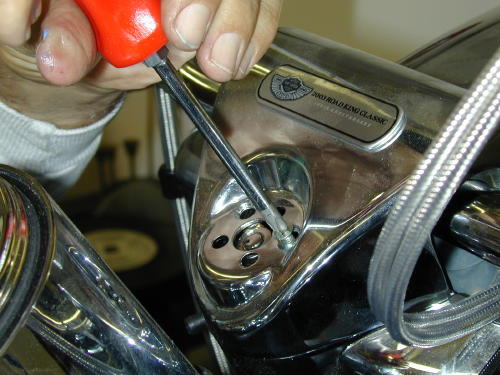
We could screw the riser down with the Phillips screws and replace the snap-on ignition ring last. I still don’t like the way it fit and need to check it again.
By noon on Monday we had completed the Highbar installation and I was itching to hit the road. We had moved our appointment at the fleet center from Friday to Monday morning, then to Monday at noon. We didn’t roll up to their doors until 1:30 p.m. and Alan, the master mechanic announced that he was leaving at 4:00. We were burnin’ daylight once again. Would the pressure every end?
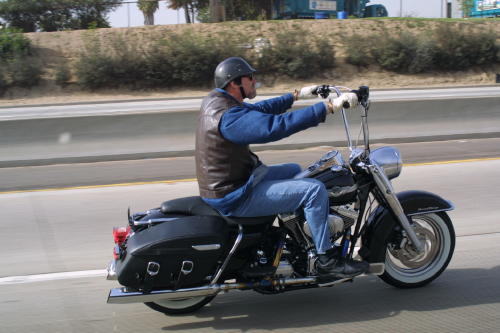
The final Frank shot with one hand hanging outside of a van window. I want to thank Frank for the use of his tools and his photographic and technical skills. Those elements and my bumbling hands make these techs as complete as they are. Believe me, it’s a bastard to build a bike, write a tech and take the shots at the same time. We’ve done it before, but a team efforts helps a helluva lot.
Next, we’ll install a performance package with Screamin’ Eagle heads, cams, air cleaner and two into one exhaust that we had jet hot coated. Hang on.
–Bandit

Road King 4/26/04
By Robin Technologies |


Over the last year we’ve tore into this classic 2003, 100th anniversary Road King. I figured I wanted a touring bike for the long haul. The notion was designed around maintaining the 100th theme, adding to the blackness and durability. I wanted a tough black bastard to ride, not detail or polish for shows. A bike for years to come. What could be better?

We kicked it off with light styling and safety accessories like a blacked-out dash, lowered shocks, rewired turnsignals, touring components and detachable back rests.

We worked with a dealer for more involved tech mods and performance enhancements. Our formula was designed around beefing the low-end torque with cams, Screaming Eagle heads, air cleaner and two into one pipes. I ran it directly from the lift to a dyno, for a comparison test, which resulted in 68 horses, an 8-horse increase and 76 pounds of torque, a 6-pound increase.


My old school notions leaned toward blacking out the king. If the frame had been another base color we might have followed it, but unity was the slogan behind design changes. I worked with Custom Powder Coating in Dallas as we stripped the touring model, inventoried the elements and sent them to the masters of powder (214)638-6416.

I rode over to Henry Figueroa’s Auto Restorations, a steel corrugated building on the wrong side of town. We removed the license plate holder and rear plastic fender tip. The filling and paint came from Henry (310) 218-9097. Henry filled the holes in the bottom of the fender and prepare it for George, The Wild Brush, to perform classic pinstriping magic (310) 488-5488.

I wanted to flame the bastard but paid homage to the 100th anniversary of H-D, reluctantly. We compromised and snatched the gold and silver (or gray) from the edge of the 100th tank band and expanded it to other elements of the King.

We installed a factory oil cooler and tested it on the road to Barstow, California. Every goddamn element was covered in techs right here on Bikernet. Keeping the oil at a resonable temperature is critical to long rang reliability.

Since I might ride the King to Sturgis this year and pack a Bikernet babe, we installed a detachable back rest for long distance runs.


“It could be flamed and raked,” Renegade shouted from behind his rigid, kicker-only, magneto charged Shovelhead.

H-D Lowered shocks — For coolness without disturbing the ride.
H-D Shock pump tool — For ease of modifying and checking ride ability for singleor double-up runs.
H-D Taillight/brake light mod — To turn the turn signal lights into brakelights for added stopping visibility.

H-D Digital dipstick — For ease of observing oil temps.
H-D Docking kit — For backrest and fender rack capabilities.
H-D 100th Anniversary Cobra style seat — For coolness.
H-D Blacked out dash panel — For coolness and lack of sun glare on the openroad–get it?

H-D Crash bar bags — For additional touring space.
H-D Mobil windshield — For low or high touring.
H-D Windshield bag — For windshield storage
Screamin’ Eagle Teardrop air cleaner cover–Style.
Screamin’ Eagle Heads–Enhanced flow and increased compression.
Screamin’ Eagle Air Cleaner Kit–Improve air velocity
Screamin’ Eagle Two Into One Touring Exhaust–Matching exhaust with heads.
H-D Speedo/Tach–More tuning information for the rider.
Screamin’ Eagle EFI turner kit–Tuning software.
H-D SE-203 cam set–Specific low end/mid range performance enhancement.
Goodrich Hydraulic lines and fittings–Extended lines for highbars.
Barnett’s Tool– Extended throttle and clutch cables.
Custom Chrome 16-inch High Bars–Changing the nature of the beast.

H-D black mag wheels and floating rotors with black centers–Adding to the blacked out look.
H-D fender brackets–Allowed the solid black Street Stalker fender to be bolted to the touring front end.
Screamin’ Eagle teardrop turnsignals and the narrower light bar–All style
H-D fender, license plate mount–Moved the bracket out of the way.
H-D New oil cooler for 1999 and later touring models–essential to cool the King.
H-D custom billet tab for the rear of the stock seat–We needed an extra one.
H-D Front and rear detachable docking hardware kits–Allows for detachable touring accessories to be mounted
H-D Lower backrest/sissybar–Designed to pleasure the ladies.

H-DClassic hexbolt covers and stainless Allen caps to begin an engine detailing process.
H-DClassic Chrome Axle caps–Factory styling additions that prevent chrome shop runs.


Sturgis 2000 – Part 2
By Robin Technologies |
| That afternoon, I finished the weekly update and jammed for the tilting garage. Nuutboy had already broken under the extreme pressure and hauled ass for foreign shores. Wrench checked into rehab for the 24th time.
He had been awake for three weeks and was beginning to look like the guy from the “Living Dead.” Japanese Jay threw up his hands, jumped on the bike from the Harley fleet center, and hauled ass for the border. Renegade bitched and moaned, but under his breath, after smoking several joints, said, “Nice bike.” We knew then I was good to go. I dialed Giggie in a frenzy, “Could I have knocked the clutch hub loose?” “Don’t sweat it,” he said, “It’s tight, but what about the plates?” We had installed a plate wrong and metal-to-metal grating was taking place. With that fixed, I moved on to a shim to prevent the starter jackshaft from peeling away the aluminum on the inside of the BDL support bracket. I was beginning to feel that tight feeling of a motorcycle without any loose ends, except for the speedometer, which I was holding in my hand behind the top triple tree. It seemed to fit and I ran the cable. No problem except the cap holding the cable into the bottom of the speedo didn’t seem to work. It came with another cap and that didn’t work either. My mind raced with options. Throw it into the street and forget it? Find something with the correct thread size and make a cap? That seemed to be an option and I jumped into the flamed T-Chicken and roared to the marine store.
The threads were fine and the same size as any toggle switch nut, except nothing was available except toggle switch waver nuts. I tried the hardware store. The owner who never smiles, then the employees, the Asian with one bad arm who doesn’t speak, and the Hispanic who is always eating burritos no matter what time of day it is pointed at the fastener wall and ignored me. I searched and searched until I had to ask for help. They shook their heads and I searched some more. I screamed, they hid behind paint cans. I couldn’t believe that they would have every size 1/2-inch nut except this one. I roared off to Neptune’s electronics. The owner, in the shop that hadn’t changed since the ’50s, looked at me and said, “Yep, had some of those, but I don’t know where.” He didn’t and I left feeling dejected. It was almost 4:30 as I tore along the harbor while dialing the cell phone. “Phil,” I said gritting my teeth, “You know anything about speedo cables?” “Yep,” he said, as he eyed my CCI cable, “it’s easy to get these things wrong,” and referred me to Drag Bike Engineering on Artesia Boulevard in Gardena. I drove up Western Boulevard, which sucks. It runs north and south through the middle of the Palos Verdes Peninsula. It’s a four-lane boulevard that’s bordered by every goddamn franchise jip joint, fast food place, square boring store front on the planet. The only item it contains more of is stop lights. So I drove, and stopped and drove, and the street narrowed. I rolled out of San Pedro into Lomita, then Torrance and into some places I had never heard of when I finally hit Artesia. I hung a left and there was Drag Bike Engineering, a clean, well-stocked shop. Phil told me to ask for Jim and I did. Only two knowledgeable riders were in the pristine shop and one said, “Don’t I know you?” I looked at him hard and thought about all 30-some years I’ve been riding and stumbling in and out of events, parties and runs. I hadn’t a clue. “Yeah, a couple of years ago at Kern River,” he said, smiling. The most vivid memory of the Kern was hitting a guy in the face with a bottle of Cuervo Gold ’cause he pulled a knife on one of our guys for the second time. I warned him the first. It wasn’t him, thank God. I introduced myself again, apologized for not remembering anything except what was on my check-off list for Sturgis and asked about the cable. Jim came out from the back. “Yep, those cables are tough to match.” He wandered over to his rack, pulled off another CCI cable and tossed it on the counter. “See if this will do the trick.” I pulled my knife and began to slice at the plastic wrapper, immediately slitting my thumb wide open. Maybe the pressure was getting to me. The cable was perfect and I bled all over his counter. Jim gave me a Band-aid as his partner put a plastic coating over the braided cable and I hit the road. Good byes are tough, sometimes, and we bounced joyously into the wee hours before she slipped from my arms and into the harbor night. Blissfully high on several stimulants, I attempted to mount the speedo. I had to drill a 3/8-inch hole in the top triple tree. I did so crooked and with that disappointment dampening a near-perfect evening, I went to bed. I was beginning to cut into overtime. Had the Agent left from the east coast? I could care less. He had his bike a month ago. If he chose to dick around, well that was his problem. I had my list to contend with. The final nights were spent saying goodbye to a woman who had made my summer come alive. She was different than so many women I had met. There was no pretense. She had been born and raised in San Pedro and she could give a shit less about Hollywood, stardom or money. She lived a simple life as a single mother of three kids while looking after her aging father. She had roots and was securely attached to them. There appeared to be no agenda, although since splitting from her abusive biker, druggie husband of 15 years she felt ripped off by him and life. She wanted the family /husband and ordinary home and hated the fact that it all was torn from her. There was also something nasty about this woman who seemed to glide along on tender feet. Her dark wavy hair looked wonderful no matter how she combed it. It seemed astonishing that if she grabbed it and shoved it into a rubber band she suddenly took on a whole new look, yet just as beautiful as the one before. She also had a thirst that once unleashed seemed to permeate her being. If I cared for her, she blossomed, like a brilliant sunlit bloom. And so her sexual appetite was replanted in fresh soil to flourish. It’s as if a woman needs only to have the door carefully opened and the bud goes wild. As I sat back and watched this flower bloom again and again, I relished the minutes we had together. Although my body was floating on air, my mind was aghast with the trivial elements of the trip. I awoke with a start. Only 24 hours to go. She held on as I threw socks over my shoulder into the pile burying the Bandit’s bed roll and began a hectic countdown. The morning began with calls to the patch maker.
He gave me some bullshit story about a supplier overseas after the son of a bitch told me they did all their work in-house. I made my way to the garage and reinstalled the speedo several times, corrected the clutch and then hit the spare bedroom and the pile of laundry over the bedroll. I loaded it and unloaded it, checked and rechecked. Then I slipped the heavy bag above my headlight. Tie wraps usually work well to hold it in place, but sometimes not well enough. It seemed to shift six inches off center as soon as I stood the bike upright. I fired the loaded bike in the late afternoon and headed for a refueling station. The Blue Flame had less than two miles on the new speedo when I pulled it back into the garage for final tightening. It was good to go and she was about to come. I locked the back door. The next time I would open it would be to head out at the crack of dawn the next morning.
I had planned to wake up at 4 a.m. and leave at 5, but when she rolled on top of me, for some reason I couldn’t move or toss her aside. I didn’t struggle, but as the sun broke above the harbor like a fresh egg cracked into a hot frying pan, I pushed the rigid into the growing warmth and fired her to life. I pushed off with a full tank of gas and no idea of my capacity or mileage. I rolled along the harbor as the 18-wheelers were beginning to rumble in and out of the teeming container docks. The tug whistle blasted above the sound of my modified drag pipes as I rolled onto the freeway heading north to the 91 and north again to the 605 and north again to the 10, where I would set for 430 miles, heading east to Phoenix. I have a code, that I like to cut through at least 100 miles the first leg out. Depending on the length of the day, I slice off smaller chunks as the day dwindles. You know the saying: “Let’s ride, we’re burnin’ daylight.” My first stop was 101 miles out and the tilted, 3.2- gallon gas tank took 1.841 gallons. That was 54 miles to the gallon. I stopped just past Yucaipa, and I thought of Rip and all his trips from Yucaipa to the Valley. ‘Bout 100 miles in rush hour traffic to work on a motorcycle is nothing to sneeze at, and it’s surprising that something other than motorcycles killed him. As I fueled, I started to strip off the outer layers. Since it was cool when I left, I had on thermal undies, Wranglers, an Excelsior-Henderson sweatshirt, the Prison Blues denim and little Joe’s leather vest, except this one I ordered in brown. I had to wear something different and it was cut larger than the first black one. I would like to be able to afford another lambskin shirt out of brown, also. In the process of stripping off the jacket and strapping it to my bedroll along with a spare primary belt, I bungeed the bedroll to the trees and bars and it quit bouncing around.
I rode another 30 miles and came across Hadley’s, a famous spot for date shakes. Unlike my usual gotta-get-there demeanor, I pulled off the freeway and took a break. Already I was feeling solid about the bike as I stood and watched the sun turn up the amps. The outlook for flat Phoenix was 115 degrees of misery, and I would be riding into the pressure cooker just when the flame reached its max. Behind the scheduled departure time by one hour, I felt both the pressure to keep moving and the release of being on vacation. Yet was this competition with the bastard on the far coast a vacation? Or was it an endurance contest to test my cracked and bruised bones to the Black Hills on a rigid? A rigid? I pondered the question. I hadn’t noticed any discernible terror permeating my 52-year-old muscles or frame by the rigidity of the structure I was riding. Was I deceiving myself about the ride or was it acceptable? Without checking a damn thing on the bike, I gulped down the mixture of dates, bananas and ice cream and hit the road. Damn, that was delicious, but I had a desert to cross on a new motorcycle, through a no-man’s land during the sizzling summer. I kept telling myself that this Sturgis would be different. I was riding a rigid. I would take it easy. The bike needed a break-in period, it needed to be checked out, watched over and I wasn’t no spring chicken. Fuck all that shit. I had worked hard all summer building two bikes. I’d been riding bikes before I drove a car so I wasn’t going to change my style. I rode hard and the bike was going to be forced to handle it. I kept moving up the freeway, through Palm Springs toward Blythe, on the border of the sunshine state and Arizona. For me, Blythe represents reaching the outskirts of Los Angeles and escaping into the forgotten lands of a desert, of Indian reservations and not much else. I like that. I enjoyed the two-lane road that meandered through the low shrubbery and intermittent cactus, surrounded by miles of fine white sand that stings your eyes and catches in the sweat on your sunburnt brow. There’s a silence out there, a solitude that’s hard to find in L.A. Sure, once out of the city there are other counties, other communities, but it’s all the same. One franchise after another, shouting at travelers from the sides of the freeway. I needed to get away and I don’t feel as if I’ve gone a mile until I hit Blythe. It’s a small, sun-bleached truck stop in the middle of nowhere where a biker can refuel and have a meal, then ride a mile to the border and shit-can his helmet. The remainder of the trip would be helmet free. I pulled in under a canopy at the Chevron and refueled. It was hot and I took my slicker, spare drive belt and Prison Blues jacket off my bedroll and unzipped the tool pouch. I have a pack of Allen wrenches in the pocket. I went in the station after refueling and stretched in the cool air of the interior. The two girls behind the counter gawked at the road warrior standing before them and hurriedly gave me the change for my jug of chilled water. I could feel them checking me sideways as I walked into the sun. I had passed a caravan of VW drivers on some sort of product test. The group of Europeans compared notes about the cars and tried to discuss my stretched chopper with me. I don’t speak German. Hell, even my Spanish is rough, but I made do.
I tried my best while adjusting the peg angle on the Joker machine forward controls, to tell them the code of the west and how choppers had taken California from the Spanish. They wandered off pointing at the Blue Flame in amazement. The bike was handling well and the ride was superb. For A rigid, I seemed to be floating on air. I must give the H-D folks the credit and Nuutboy, the man responsible for narrowing the seat pan and building a support frame under the seat. There was no side-to-side slack. The up and down movement was unhampered and the springs carried my weight without a problem. When I first hit the road, I was concerned about my fat-assed weight on the two spindly coil springs and tried to sit forward on the seat to prevent fatigue and over extending their life. I realized before long that there was no way I was going to put my riding position behind the longevity of the springs. I couldn’t stay focused on preventing trucks from running over me.
The Joker Machine pegs were well designed and executed. The were designed to allow me to change the angle in case my feet were vibrating off the pegs and change the pivot angle. I made one of the pegs flat and slightly lifted the heel rest on the other. It was a test. The polished chrome surface of the pegs was slick and my old Niki hiking boots were dancing off the surface, precariously close to bouncing off the brutally abrasive concrete below.
I chose to wear these leather, low-cut boots for a couple reasons. I generally wear leather cowboy boots. Here’s why: If you wear tennis shoes or rubber soled boots and need to put your foot on the pavement while the bike is rolling, anything that sticks will shove off to the rear and you’ll immediately find yourself bouncing along on your knee. If you can’t put your foot down in an emergency, what the fuck good are you? Many riders wear rubber-soled boots for a specific reason: They’re resistant to oil and chemicals. If you’re in dust or dirt and trying to push your machining around, you get better traction (you should be riding, not pushing). But that’s slow-speed shit. To me, it’s the fast shit you need to concern yourself with. Your boots should have tough but slick leather soles for serious survival. So when picking my wardrobe for the run, I wanted something with some give for the slick foot pegs. Leather soled boots would glide right off. On the other hand, I wanted something hard enough to be less than tire-sticky on the pavement. These hardened Nikis seemed to do the job. Fortunately I never had to test their high-speed capabilities. With the pegs adjusted and enough water in my gullet to keep me from passing out in the heat, I rolled out from under the shade of the gas station canopy and back into the blistering sun. I pulled off the side of the highway under a sprawling billboard welcoming me to the Arizona desert ahead. The sign said freedom to me. I wanted to yank off the jockey-styled helmet and throw it in the gulley with the creosote, tumbleweed and empty junk food containers that line Interstate 10 all the way to the east coast. I let my helmet go a couple of years ago in Utah on my way to the rally, but this year my budget was tight. It took every dime to build the bikes and pay the bills before I headed out. I left Los Angeles with only a $100 bill in my Wrangler pocket. My brother in Phoenix would refill my run fund because I had put our Sturgis motel on my credit card. I would take his cut in cash. Enough cash to keep me going, I hoped. With 160 miles left to make the 429 to Phoenix, I kept rolling. I was already confident that I could make 100 miles without hitting reserve, so I cleared the trip gauge before I left each gas station and it acted as my gas gauge. As I rolled into the desert, the sun was reaching noon high and I thought about the machine beneath me. There’s a sense of fight and might or doom and gloom in each machine I ride. You just know after a couple hundred miles whether the bike is good for the long haul, hanging on for dear life or crumbling under your feet. It’s a matter of sound, vibration and a feel for the driveline balance. I had worked hard to keep the driveline poised, but I had no concept of how the Daytec frame, the Weerd Bros. front end or the Road Wings wheels would stand up under the continued strain. I had been disturbed at the poor pre-load spacing of the Timken bearings in the wheels. The company seemed to be floundering. A collapsed wheel at 80 mph would make me wish I had skis strapped to my ankles. I had allowed a longtime friend of mine and a man who understands and owns long bikes ride my bike during the break-in period. I rode along side him on his black West Coast stretch. I concentrated on watching the frame and front end on the uneven surface of the Santa Monica Freeway. I was surprised to see a 14-over front end work that well. The polished aluminum tubes glided effortlessly up and down after I had installed six ounces of heavyweight Rev Tech oil in each already-wet tube. If the front end had been dry, we would have poured eight ounces in each. The wheels were hard to read. I hadn’t balanced the front, but it didn’t seem to hop on the grated concrete. When the pavement was smooth, the bike appeared to glide along. As I reached the California border, I knew I had over 500 miles on the engine and could raise the speed limit. Until that point, I had kept the revs alternating and not locked on any particular speed, but now it was time to start checking the vibration barriers. I wanted the engine and driveline to hang tight up to about 80 mph and so far the vibration was minimal past 70, so I worked up the speed slightly to test the resonance. Some 20 miles past the border, I began a 75-80 mph test. The adjustment to the foot peg angle worked perfectly. No longer was I forced to put slight pressure on the outside of my feet to hold the hiking boots on the pegs. The back and forth pivot adjustment seemed to afford me a better position for resting my feet. At times though, I wished for mid controls. I could push it to 80 mph and my feet stayed on the pegs. I began rolling at a constant 75-85 mph range. The driveline appeared to be tight. I would need to check fasteners once I rolled into Phoenix. They would tell me how the frame felt about the ride. Something else milled around in my feeble brain cells, besides my melting forehead and Agent Zebra on the east coast with a two week head start. I knew how he rode, how he abused motorcycles. He would be lucky to make it to the Florida state line. Aside from a mental check list of a myriad mechanical considerations, there was another woman seeping into my consciousness. A silky-haired Asian woman with dark eyes and a taller-than-average form. We had never discussed a relationship like I had with the dark-haired beauty. Sin would just stop by from time to time at lunch and crawl into bed almost without a word. She was emotionally soft and timid. She studied at Cal State Long Beach, something about sea life, seals, otters and such, but she grew up in San Pedro. She was young, in her late 20s, and I knew she would be moving on when the summer ended. She was a bashful volcano, waiting to erupt on several fronts. As Sturgis neared, I had become so caught up in what had to be done that I didn’t pay attention to what was going on around me. Sin became suddenly sullen about a month out. She didn’t say anything as I babbled about the bikes, the Web site and the trip. At first she seemed preoccupied with a buxom blond named Coral, whom she met at the beach a half mile away.
Coral was obviously bi and aggressive and was tempting Sin into a fling. The encounter became hot bedtime talk and our love making hit an all-time fevered pitch. Sin was aware that she was attracted to the hot blond with the bubbly personality and tits to match. Sin wanted me to watch out for her and began to talk about a tryst at the headquarters. Although quiet and bashful, Sin had a complete back tattoo with a Geisha girl at the center. A mermaid covered one shoulder, but the Geisha girl, fully clothed with a gown that flowed down her spine, was the center of intrigue. The woman in the tattoo seemed torn, yet proud and centered. As Sin bent over the bed, she talked about Coral’s body and her touch. I looked at the permanent illustration of the Geisha and could see the questioning in her eyes. I had told Sin about the dark-haired one and she respected my involvement and didn’t pressure me. This was all supposed to be fun but I sensed her attraction to Coral was growing, and I knew from Coral’s e-mails that she was hungry for Sin’s tall form, milky skin and big boob-job tits. The mixture was pure ecstasy for me. I was dancing on a dangerous cloud and as I headed across the desert, gradually twisting the Joker machine throttle farther and farther past the 85-mph line, I realized that emotions were beginning to reach a collision point. Coral was introducing herself into my life, one that was being shared by the unknowing dark-haired beauty with a quiet stillness about her and Sin, a women so beautiful I knew the thought of keeping her was out of the question. It was a firy bouquet that couldn’t bloom for long. An 18-wheeler retread exploded and pieces of tire jettisoned in every direction. The truck directly behind the offending vehicle veered and for a few treacherous moments it acted as a steel snake slithering in and out of my lane. I may fall apart in some situations, but in an impending accident I become calm and watchful, hoping to make the appropriate maneuvers. I kept my eyes open for a slight movement, an escape hatch, or another idiot to become involved. I blasted through a cloud of dust and returned to my thoughts of Sin’s tits bouncing below me, her sleek youthful fingertips taunting her nipples, and her words of lust toward another woman drawing me to the brink. Many times I craved for the bikes to be completed so I could have Sin over more. Tonopah finally showed up on a sign as I careened past at 85 mph and the ambient temperature passed 100 degrees. I pulled in and refueled. I was still pulling down 50 mpg, which blew me away. Theoretically I could get 150 miles out of this shapely 3.2-gallon Sportster tank. One of these days, I would like to take two weeks to get to the Bad Lands. I’d like to ride like a fuckin’ tourist, taking all the small roads, gawking at the tundra and pulling off at the viewpoints to check out the majestic canyons. Instead, I ride like I have one day left to live, like I will receive a ten spot for every vehicle I pass, and I want to make a million in a day. It’s fun, I can’t deny it. On the other hand it’s ridiculous. A small Lexus will do 160-mph without blinking an eye and could out-accelerate, out-maneuver and outrun my ass, yet I’m the one pushing the limits. Guess I’ll never learn. I had an ice cream in Tonapah and every son of a bitch I passed over the last 100 miles gently rolled by while kids in the back listened to CD’s and the folks bitched about loud bikes, promising to write their senator when they returned from vacation. Truckers I had blown past rolled on by and by the time I got back on the road I could ride for all I was worth (not much at the moment), and I could just catch ’em before I hit the city limits of Phoenix. But goddamnit, I was going to give it a helluva try. I fired up the Blue Flame, dropped the clutch and wheelied onto the freeway. “Look out you bastards, I’m comin’,” I screamed as I hit 80 mph and merged into the No. 2 lane.
I have yet to read a map before entering the Phoenix freeway system. I always roll in and wonder where the fuck I am. I ask around and finally find the way to Easyriders of Scottsdale. This time, the I-10 interchange was closed and I was forced to exit. As I pulled off the freeway, I asked a bunch of Native Americans in the pickup next to me how to get to Scottsdale. They looked at each other in bewilderment, pointed in several directions and finally the driver gave me directions that I couldn’t understand and was dubious to believe. I’m more and more surprised when asking directions of locals, the percentage who don’t know where the fuck they are. Most can’t speak English, especially kids. I asked one kid where Broadway was in Phoenix. He didn’t have the slightest. Ironically, the gas station he was working in was on Broadway. I finally got the word that I could take a big busy street directly into Scottsdale or take another one that led me through a bad section of the area on the way to my destination. It was 115 degrees when I pulled off the freeway and started bouncing from one stop light to another. My informant failed to tell me that the street I chose lead me directly into the international airport, so I suddenly found myself weaving in and out of terminal traffic. I came out of the airport unscathed and was dropped onto a freeway. I was fuckin’ lost. The freeway lead me directly to the one and only Scottsdale offramp and I gladly jumped off the freeway. I knew I didn’t have far to go to get to downtown, but I could sense the engine was tiring of the 118-degree heat and needed a break. It had performed perfectly and deserved to relax. I pulled into Myron’s Easyriders store adjacent to his Billet Bar, coasted under a canopy and shut off the engine. It ticked a sigh of metal relief as I walked into the shop and shouted for service. Fonz, the parts man, and Myron stood basking in a frosty level of air conditioning. Brownie, a veteran mechanic, immediately checked out the Blue Flame, changed the oil to straight 60 weight as prescribed by the manual for consistent temps above 80 degrees and recommended an alternator plug strap. I had made a mental note to bolt one in place several times, but never acted upon it. One of the guys handed Brownie the strap and he eyed it suspiciously and looked at me. “You like this one or do you want me to use one that works?” “Needs to work,” I said, and they found a Custom Chrome strap that I hadn’t seen before. It is held on by two case bolts and the plug can’t move. Myron owns the ER store, the bar next door and the Scottsdale Worlds gym, so when I’m in town, I have Brownie work on my bike while I hide under the misters in the Billet Bar patio and play pool. When the master of disaster can get away, we head to his gym. I was behind in my workouts so we hit it hard — chest, triceps, back, biceps and abs. I spent two hours trying to make up for sporadic workouts over the last two months. Myron’s gym doesn’t have that day spa look of soft tones and plush carpeting. It’s more reminiscent of the iron pit at San Quentin, if they allow them anymore. There’s lots of chain link separating various areas of equipment. Lots of mirrors, black rubber padding and polished diamond plate. The ceiling is high and industrial and the brother spends 11 grand a month on air-conditioning in the summer. Cindy, Myron’s wife, runs it and teaches aerobics. That evening, I had dinner with Myron and Cindy at their home, with three snarling dogs at my side throughout the meal. I wasn’t sure if they wanted me or the marinated chicken breasts on my plate. I sat very still and tried to make idle conversation before I returned to Karl’s house for the night. Karl is the fire chief for the rural metro area of greater Phoenix. He’s about 6-foot-3, 250 pounds, an ox of a man with a constant smile. Although it was 118 degrees during the day, the thunderstorms rolled in by the late afternoon and hit hard in the evening. Just as we were about to bed down, lightning rocked the windows and slabs of sideways rain slammed against the stucco home. Tree branches broke off, filling the pool with pine needles. Ten minutes into the gale, the lights went out and Karl went into action. He’s been trained to be calm when the shit hits the fan and he did just that. He gave orders, checked for electrical outages and possible fire hazards, then settled the rattled family down. His wife, the bouncing beautiful Cheri, is an emotional whirlwind unplugged, which seems to control big Karl. I was trying to sleep on the couch while the women screamed at the crackle of lightning and the crash of timbers. Flashlight beams crisscrossed in the darkness. I like Arizona, but the heat coupled with violent storms had me itchin’ to get the fuck out of Dodge. It was time to move.
|






